
A Journey of Sapphire Seas
A Journey of Sapphire Seas
Cruise overview
WHY BOOK WITH US?
- ✔ The Deluxe Cruises’ team has extensive experience in ultra-luxury cruising.
- ✔ Call now to speak to our helpful and experienced Cruise Concierge team.
- ✔ Enjoy our Unique Deluxe Cruises Bonus for substantial savings.
- ✔ Our team will tailor your holiday to your exacting requirements.
- ✔ As agents, we work under the protection of each cruise lines ABTA / ATOL licences
About Barcelona
The infinite variety of street life, the nooks and crannies of the medieval Barri Gòtic, the ceramic tile and stained glass of Art Nouveau facades, the art and music, the throb of street life, the food (ah, the food!)—one way or another, Barcelona will find a way to get your full attention. The capital of Catalonia is a banquet for the senses, with its beguiling mix of ancient and modern architecture, tempting cafés and markets, and sun-drenched Mediterranean beaches. A stroll along La Rambla and through waterfront Barceloneta, as well as a tour of Gaudí's majestic Sagrada Famíliaand his other unique creations, are part of a visit to Spain's second-largest city. Modern art museums and chic shops call for attention, too. Barcelona's vibe stays lively well into the night, when you can linger over regional wine and cuisine at buzzing tapas bars.




About Palma de Mallorca
If you look north of the cathedral (La Seu, or the seat of the bishopric, to Mallorcans) on a map of the city of Palma, you can see around the Plaça Santa Eulàlia a jumble of tiny streets that made up the earliest settlement. Farther out, a ring of wide boulevards traces the fortifications built by the Moors to defend the larger city that emerged by the 12th century. The zigzags mark the bastions that jutted out at regular intervals. By the end of the 19th century, most of the walls had been demolished; the only place where you can still see the massive defenses is at Ses Voltes, along the seafront west of the cathedral.A torrent (streambed) used to run through the middle of the old city, dry for most of the year but often a raging flood in the rainy season. In the 17th century it was diverted to the east, along the moat that ran outside the city walls. Two of Palma's main arteries, La Rambla and the Passeig d'es Born, now follow the stream's natural course. The traditional evening paseo (promenade) takes place on the Born.If you come to Palma by car, park in the garage beneath the Parc de la Mar (the ramp is just off the highway from the airport, as you reach the cathedral) and stroll along the park. Beside it run the huge bastions guarding the Almudaina Palace; the cathedral, golden and massive, rises beyond. Where you exit the garage, there's a ceramic mural by the late Catalan artist and Mallorca resident Joan Miró, facing the cathedral across the pool that runs the length of the park.If you begin early enough, a walk along the ramparts at Ses Voltes from the mirador beside the cathedral is spectacular. The first rays of the sun turn the upper pinnacles of La Seu bright gold and then begin to work their way down the sandstone walls. From the Parc de la Mar, follow Avinguda Antoni Maura past the steps to the palace. Just below the Plaça de la Reina, where the Passeig d'es Born begins, turn left on Carrer de la Boteria into the Plaça de la Llotja (if the Llotja itself is open, don't miss a chance to visit—it's the Mediterranean's finest Gothic-style civic building). From there stroll through the Plaça Drassana to the Museu d'Es Baluard, at the end of Carrer Sant Pere. Retrace your steps to Avinguda Antoni Maura. Walk up the Passeig d'es Born to Plaça Joan Carles I, then right on Avenida de La Unió.
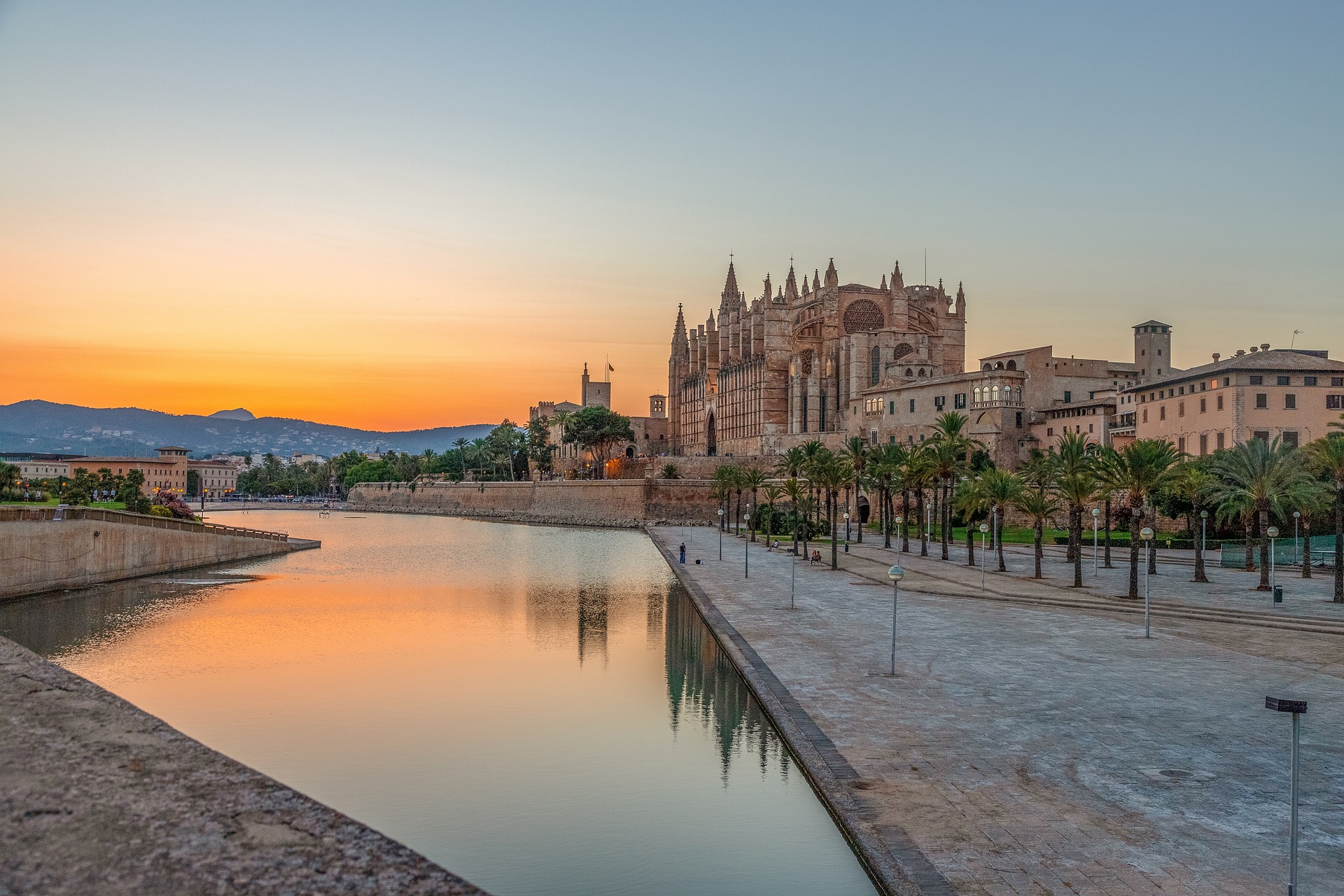
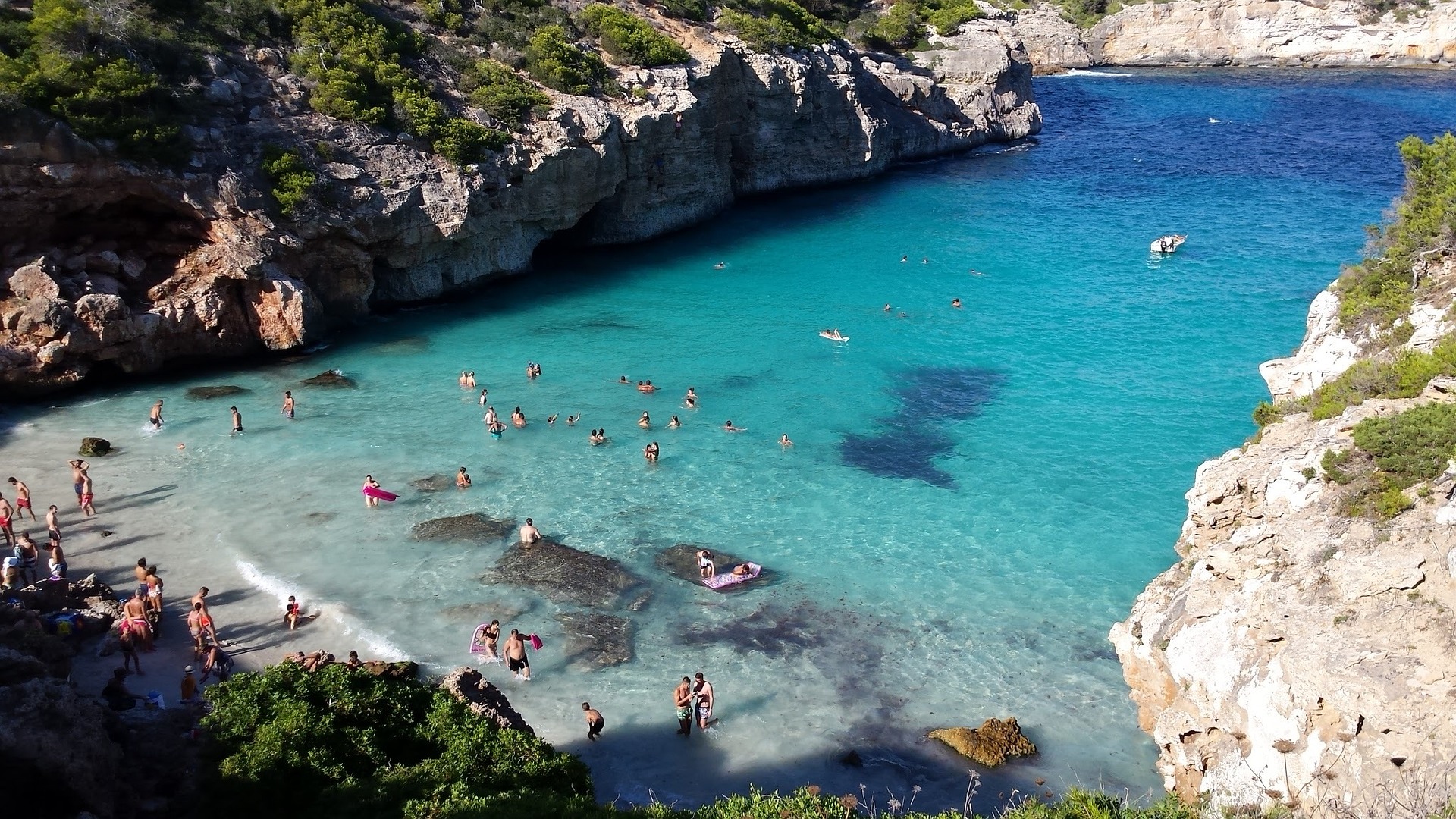





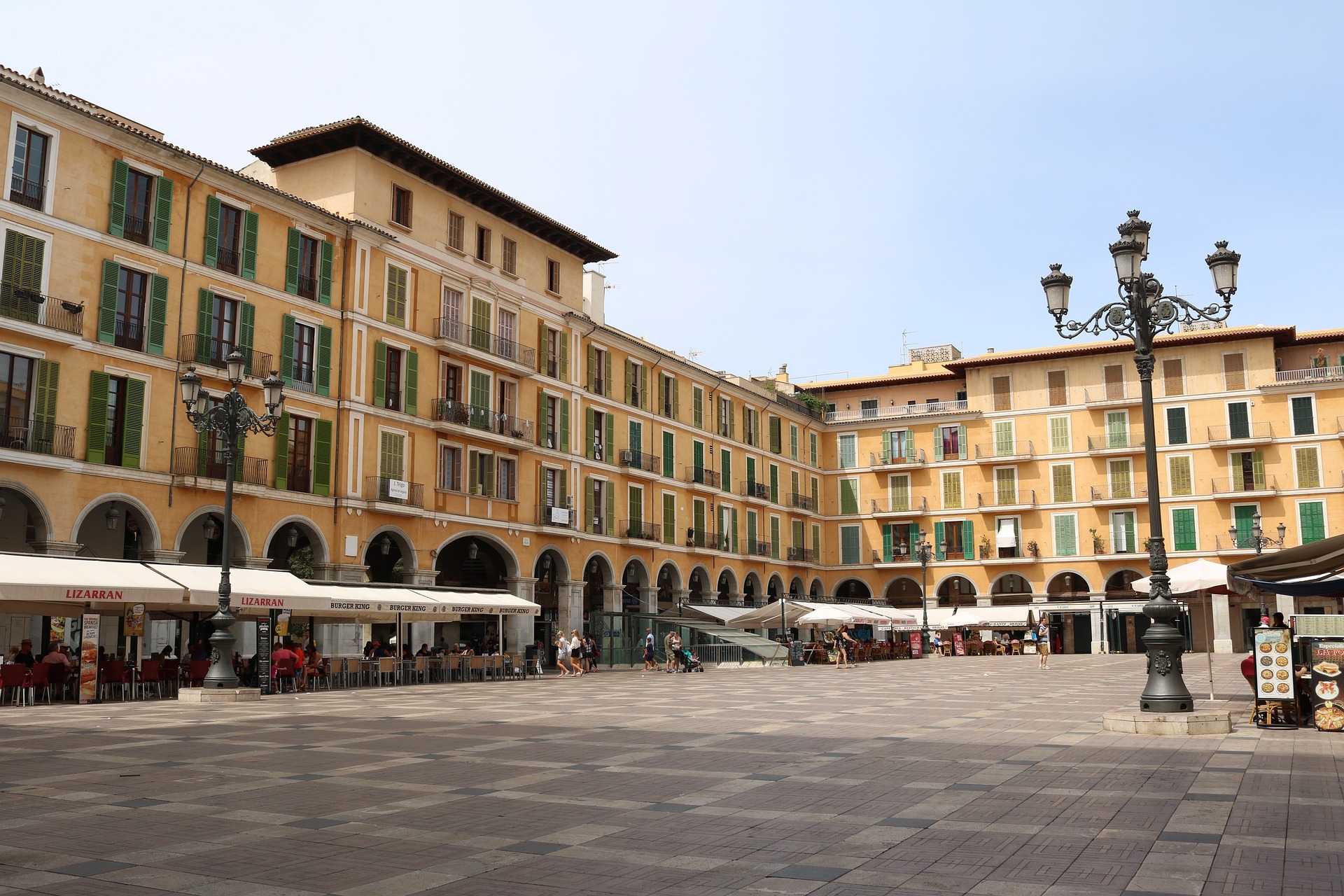

About Palermo
Once the intellectual capital of southern Europe, Palermo has always been at the crossroads of civilization. Favorably situated on a crescent-shaped bay at the foot of Monte Pellegrino, it has attracted almost every culture touching the Mediterranean world. To Palermo's credit, it has absorbed these diverse cultures into a unique personality that is at once Arab and Christian, Byzantine and Roman, Norman and Italian. The city's heritage encompasses all of Sicily's varied ages, but its distinctive aspect is its Arab-Norman identity, an improbable marriage that, mixed in with Byzantine and Jewish elements, created some resplendent works of art. No less noteworthy than the architecture is Palermo's chaotic vitality, on display at some of Italy's most vibrant outdoor markets, public squares, street bazaars, and food vendors, and above all in its grand climax of Italy's most spectacular passeggiata (the leisurely social stroll along the principal thoroughfare).




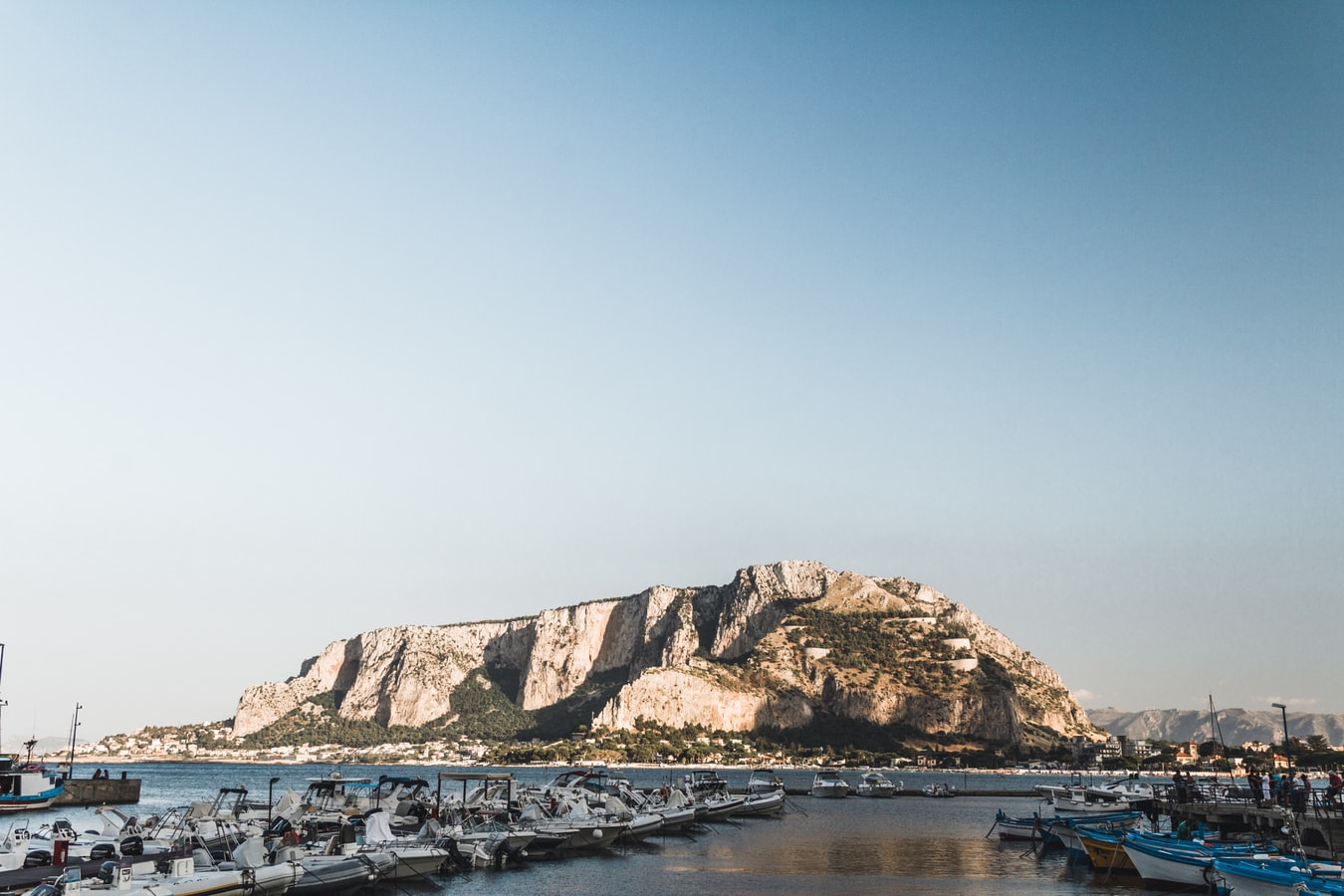
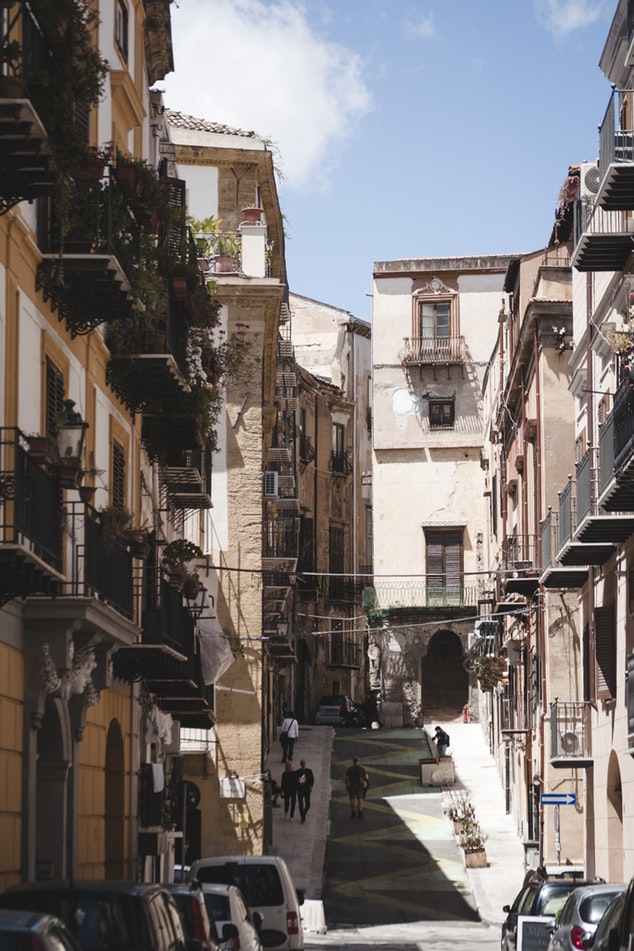
About Valletta
Malta's capital, the minicity of Valletta, has ornate palaces and museums protected by massive fortifications of honey-color limestone. Houses along the narrow streets have overhanging wooden balconies for people-watching from indoors. Generations ago they gave housebound women a window on the world of the street. The main entrance to town is through the City Gate (where all bus routes end), which leads onto Triq Repubblika (Republic Street), the spine of the grid-pattern city and the main shopping street. Triq Mercante (Merchant Street) parallels Repubblika to the east and is also good for strolling. From these two streets, cross streets descend toward the water; some are stepped. Valletta's compactness makes it ideal to explore on foot. City Gate and the upper part of Valletta are experiencing vast redevelopment that includes a new Parliament Building and open-air performance venue. The complex, completed mid-2013, has numerous pedestrian detours in place along with building noise and dust. Before setting out along Republic Street, stop at the tourist information office on Merchant Street for maps and brochures.



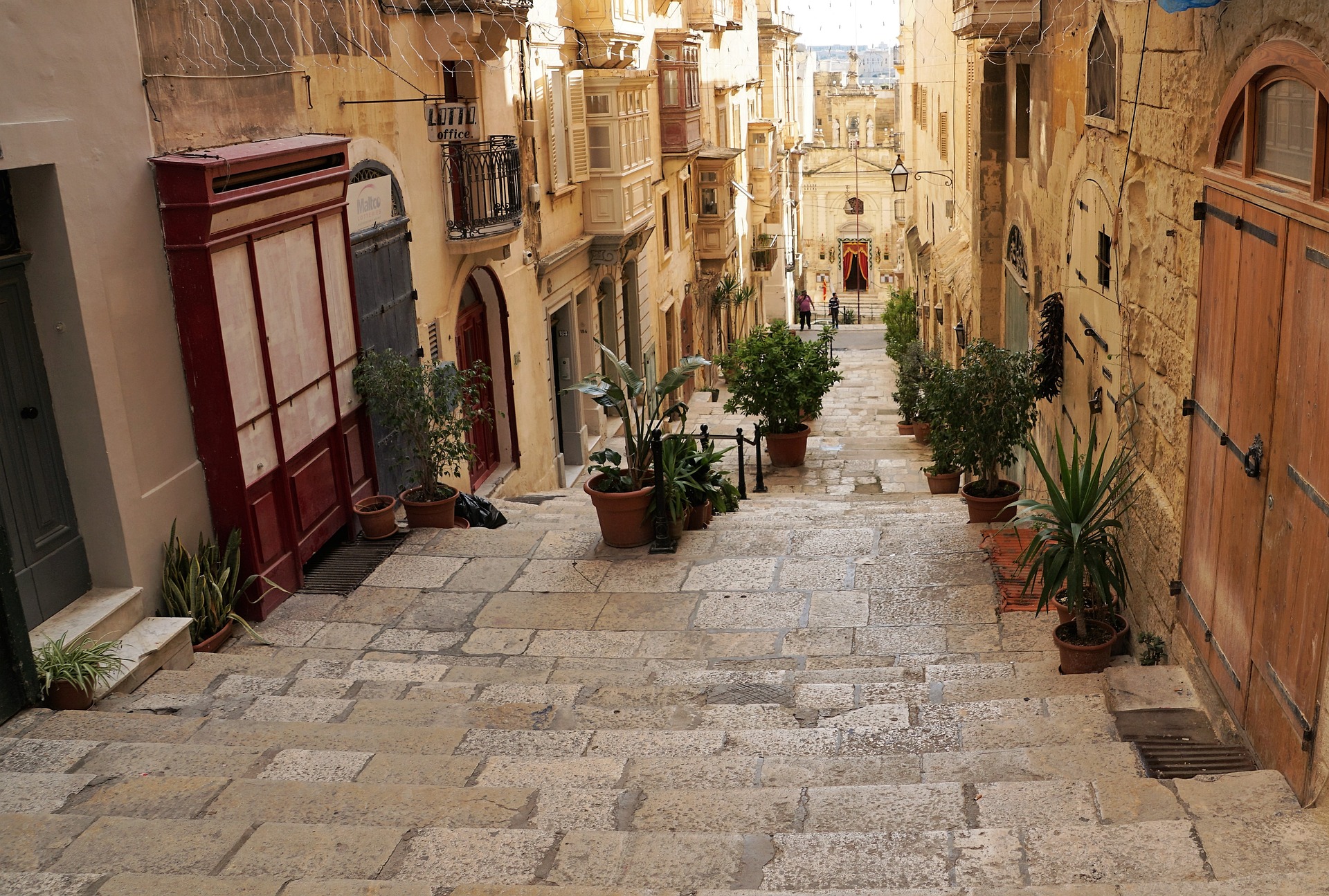








The iconic Owner’s Residence creates the largest living space on-board, with multiple harmonious spaces in which to relax, entertain and unwind.
Stand in awe of the panoramic ocean views from your private outdoor terrace – extending over the full ship's width – with a spacious infinity whirlpool, and enjoy intuitive, intelligent, dedicated private butler services by the Residence Manager.
Every aspect of the design of our Owner’s Residence reflects the meticulous curation of all details, conscious at all times of our commitment to sustainability.
Features
- Dedicated private butler services by the Residence Manager
- Oversized floor-to-ceiling windows with views of the sea
- Separate living, dining and sleeping areas
- Abundant lounge area
- Dining table for 8 guests
- Spacious work desk area
- In-suite welcome bottle of Dom Pérignon
- Private bar, replenished according to the guests’ preferences
- Espresso machine, kettle and tea pot with a complimentary selection of coffee and teas
- Complimentary personal refillable water bottle for each guest
- Pair of binoculars for guests' use during their journey
- Technogym Bench and Technogym Case Kit for an efficient in-suite fitness experience
- Laptop-size safe
- Guest lavatory and powder room
- Butler pantry area
Bedroom
- Bespoke king-sized bed sleep system - size: 200 x 200 cm (79 x 79 in)
- Down duvets and pillows
- Fine bed linens
- Extensive pillow selection
- Oversized dressing room
Outdoors
- Panoramic ocean-front terrace covering the full ship’s width, with a private outdoor spacious whirlpool, day beds, a dining table, lounge area, shower and sun loungers
Bathroom
- Luxurious marble double vanity bathroom
- Large bathtub and a walk-in shower
- Private steam room
- Plush bathrobes and bath linens
- Custom bath toiletries and amenities
- Dyson Supersonic TM hairdryer and illuminated make-up/shaving mirror
- Additional guest powder room
Butler Service
- Packing and unpacking to the guests’ preferences
- Pressing and laundering assistance
- Private in-suite dining
- Itinerary and transport planning
- Celebrations planning
- Onboard and ashore reservations assistance
Stats
- Total Suite area: 280 sqm (3,014 sq ft)
- Suite: 155 sqm (1,668 sq ft)
- Terrace: 125 sqm (1,345 sq ft)
- Maximum capacity: 2 adults and 1 child under 2 years old (in a baby cot) A connecting Ocean Terrace suite can be reserved additionally, allowing for a total maximum capacity of 4 adults or 3 adults and 1 child under 18 years old
*All images are a combination of photography and artist renderings.
The artist representations and interior decorations, finishes, and furnishings are provided for illustrative purposes only.

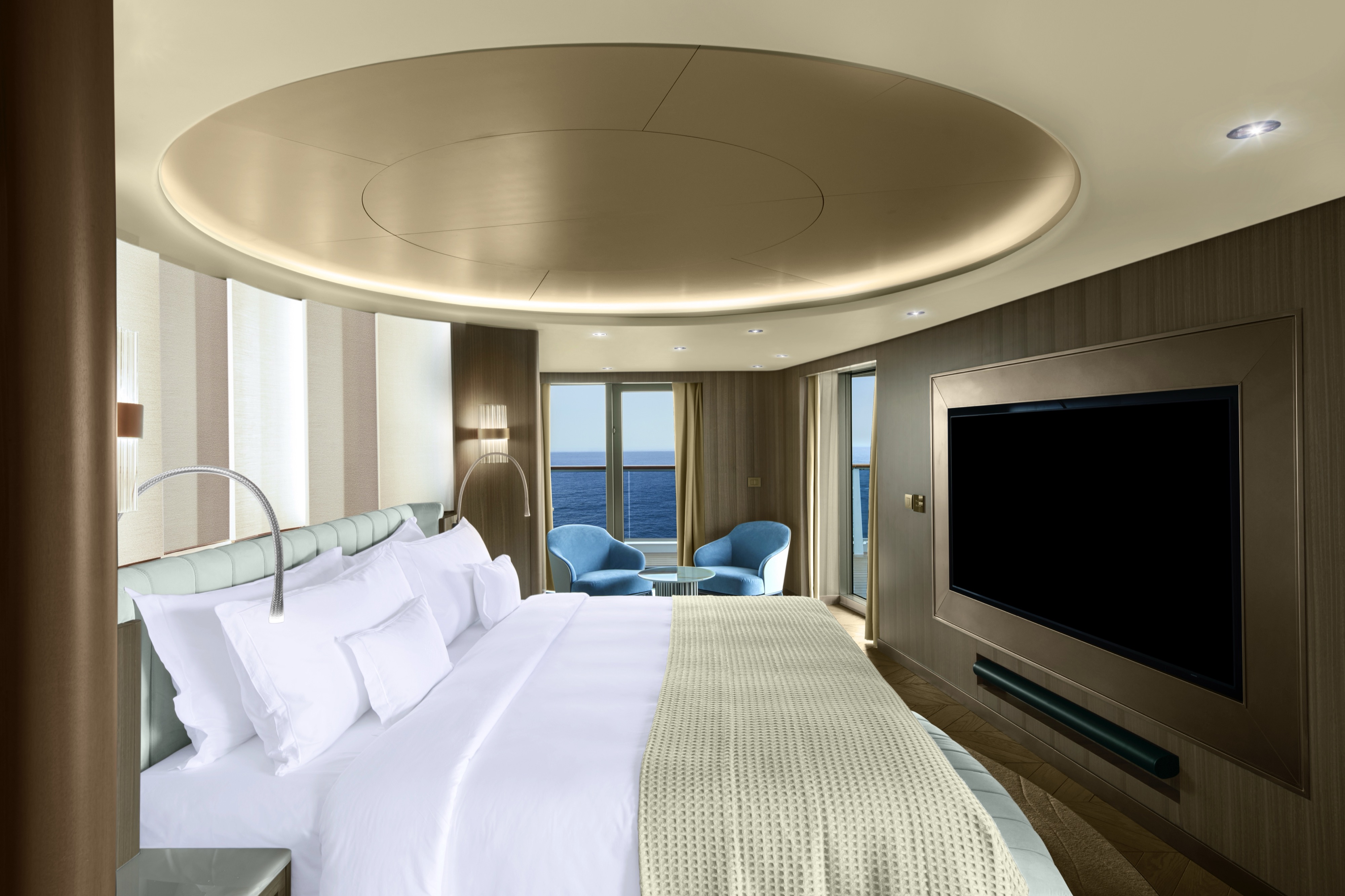


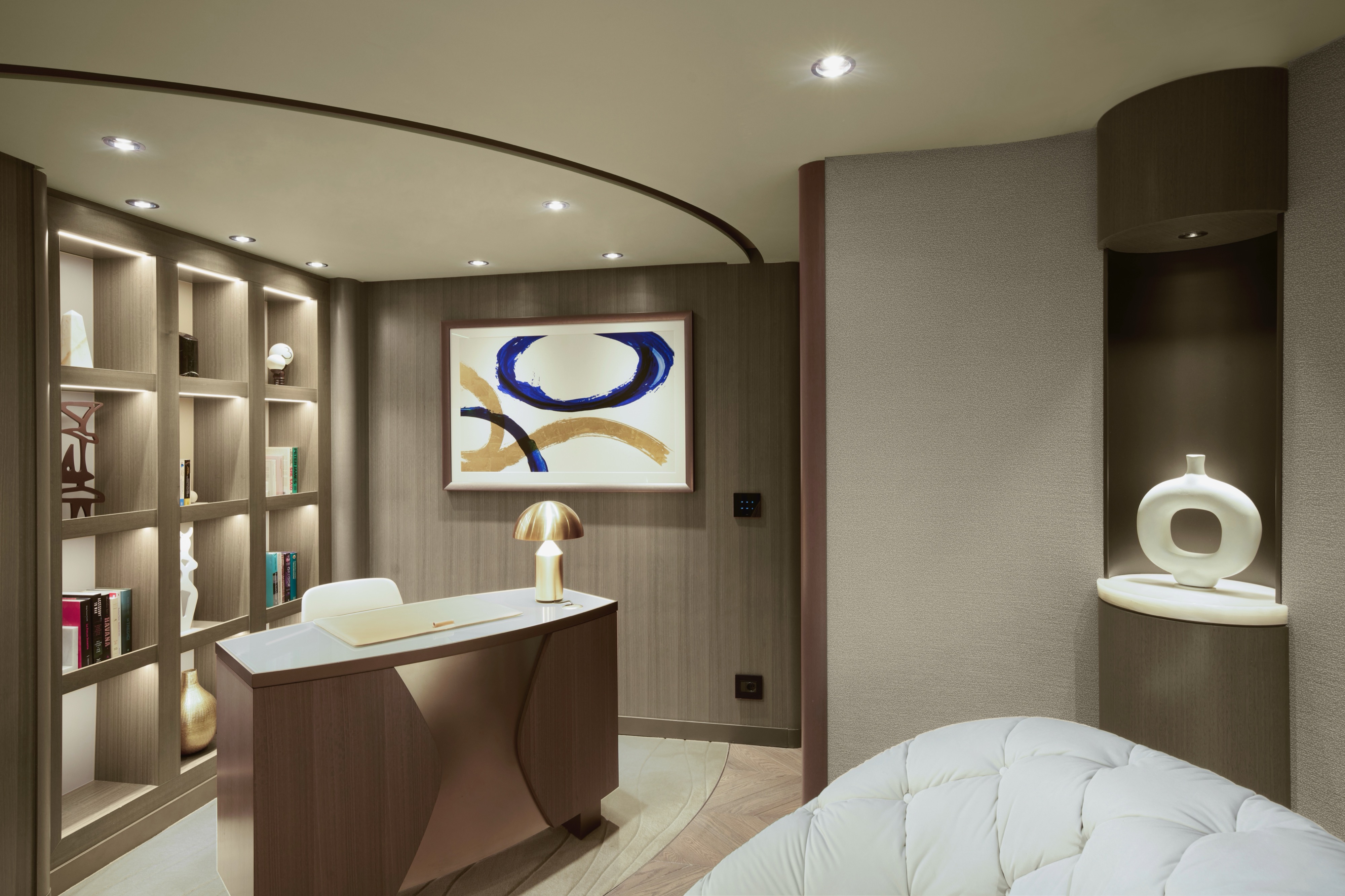
















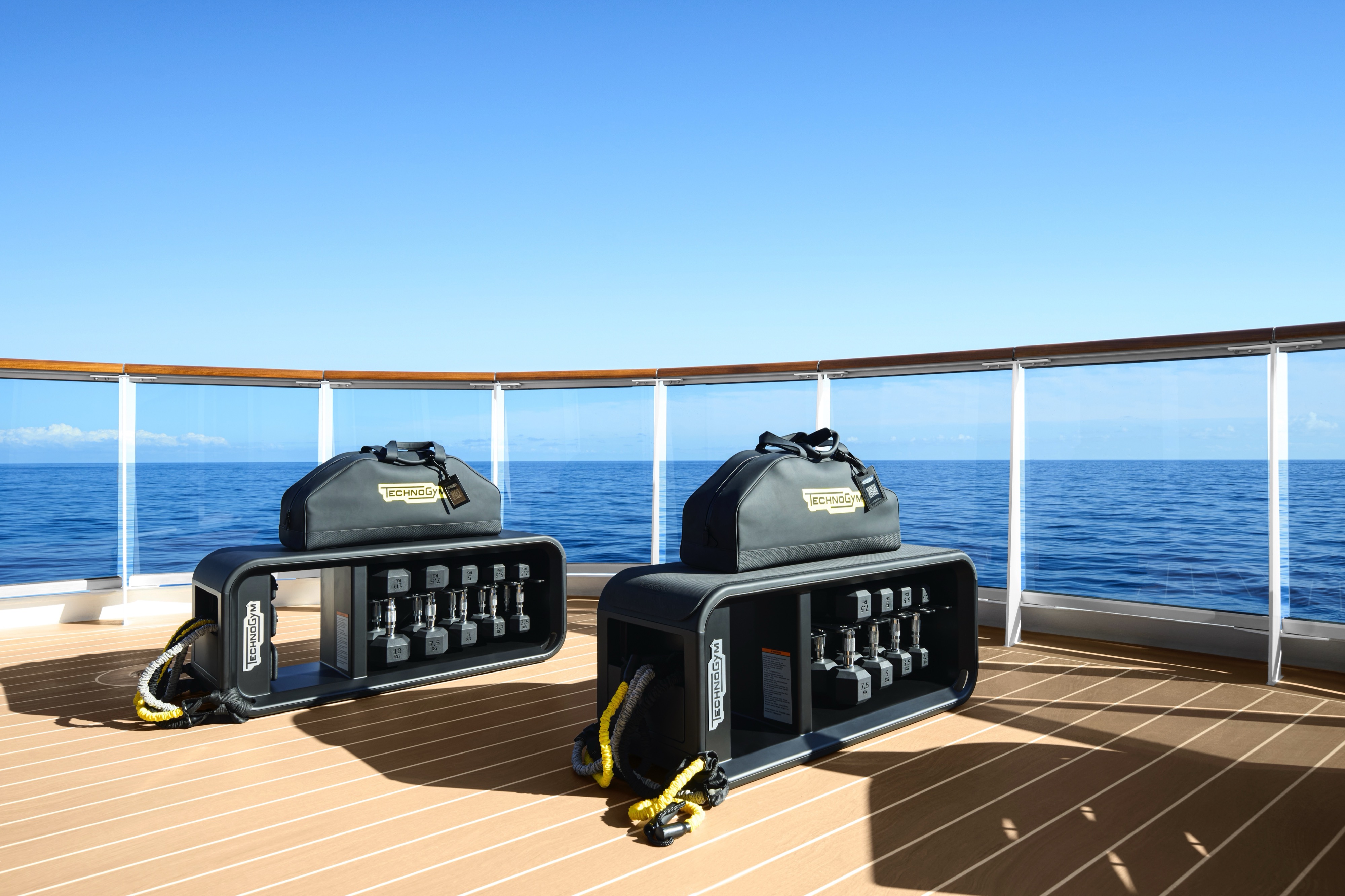

Our luxurious Retreat Residences offer oversized floor-to-ceiling windows leading onto a spacious sun terrace with a private whirlpool, whilst a Residence Host providing butler services is on hand for our guests’ every whim, as well as a dining area for up to four guests, a separate living area and calm workspace.
Features
- Private butler services from our Residence Hosts
- Oversized floor-to-ceiling windows with views of the sea
- Separate living, dining and sleeping areas
- Spacious lounge area
- Dining table for 4 guests
- Spacious work desk area
- In-suite welcome bottle of champagne
- Private refrigerated mini-bar, replenished according to the guests’ preferences from a selection of alcoholic and non-alcoholic beverages
- Cocktail making set
- Espresso machine, kettle and tea pot with a complimentary selection of coffee and teas
- Complimentary personal refillable water bottle for each guest
- Pair of binoculars for guests' use during their journey
- Technogym Case Kit with a smart range of fitness gear
- Laptop-size safe
Outdoor
- Spacious ocean-front terrace with private outdoor whirlpool and a dining table
Bedroom
- Bespoke king-sized bed sleep system - size: 200 x 200 cm (79 x 79 in)
- Featuring a double sofa bed
- Fine bed linens
- Down duvets and pillows
- Extensive pillow selection
- Oversized walk-in wardrobe with a seated vanity area
Bathroom
- Luxurious marble bathroom with a bathtub, a separate walk-in shower room and heated floors
- Plush bathrobes and bath linens
- Custom bath toiletries and amenities
- Dyson Supersonic TM hairdryer and illuminated make-up/shaving mirror
- Additional guest powder room
Stats
- Total Suite Area: 77 sqm (829 sq ft) on decks 8, 9 / 81 sqm (872 sq ft) on deck 7 Suite: 63 sqm (678 sq ft)
- Terrace: 14 sqm (151 sq ft) on decks 8, 9 / 18 sqm (194 sq ft) on deck 7
- Maximum capacity: 3 adults or 2 adults and 2 children under 18 years old (baby cot or double sofa bed)
*All images are a combination of photography and artist renderings.
The artist representations and interior decorations, finishes, and furnishings are provided for illustrative purposes only.


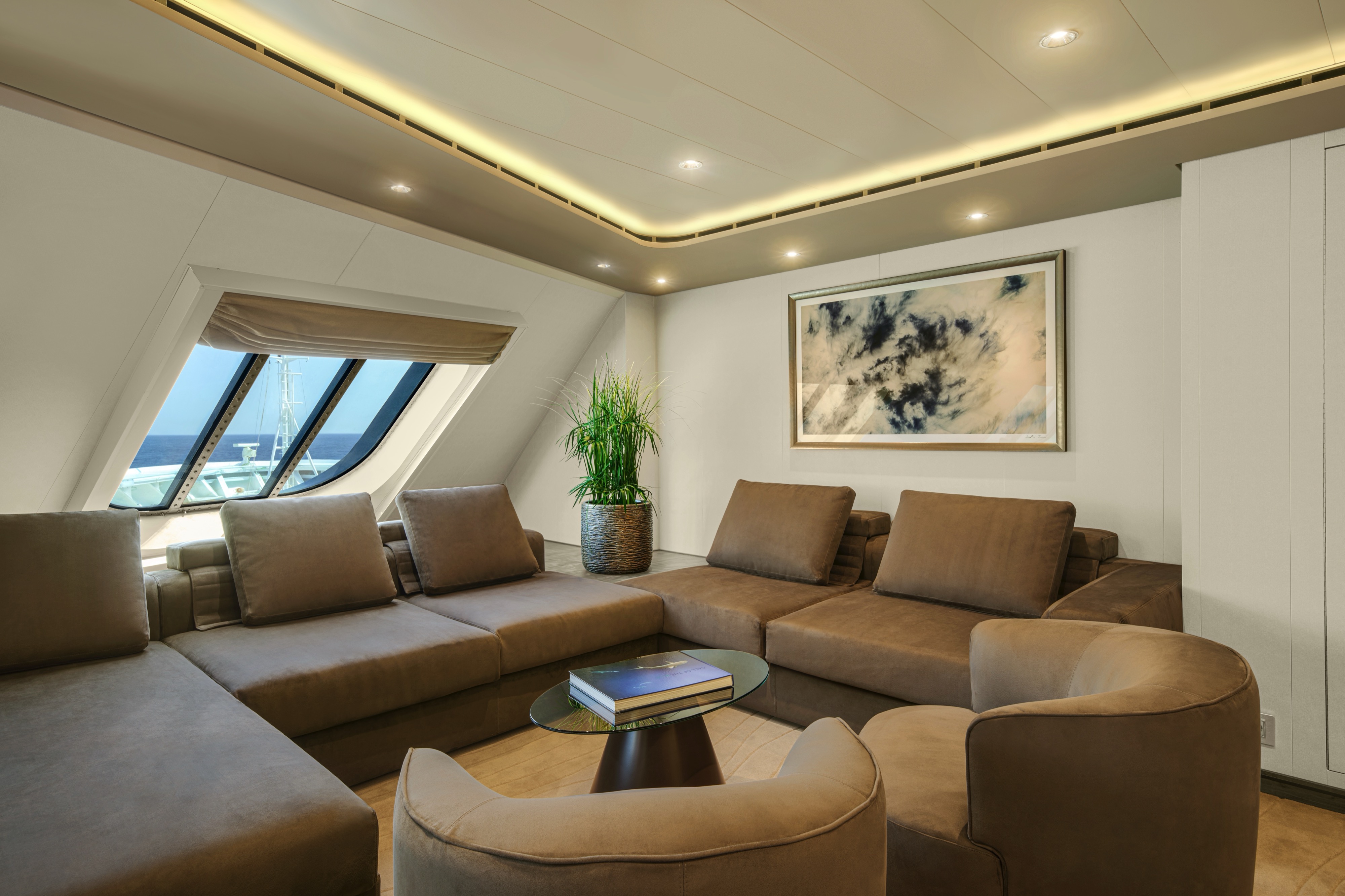


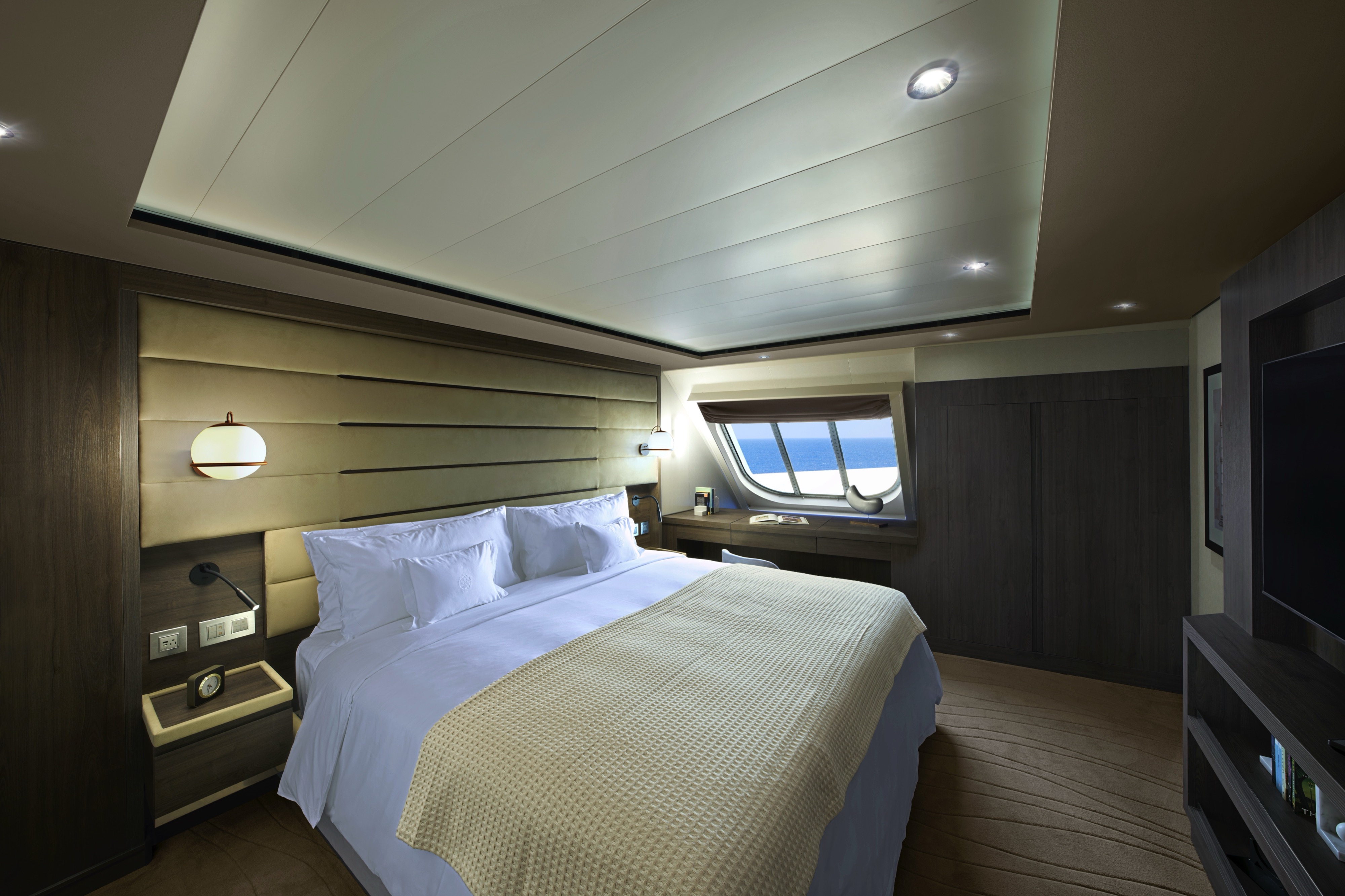




For a true sense of being at home at sea, experience the sweeping decks and effortlessly elegant spaces of the Cove Residences.
Features
- Private butler services from our Residence Hosts
- Oversized floor-to-ceiling windows with views of the sea
- Separate living, dining and sleeping areas
- Spacious lounge area
- Dining table for 4 guests
- Spacious work desk area
- In-suite welcome bottle of champagne
- Private refrigerated mini-bar, replenished according to the guests’ preferences from a selection of alcoholic and non-alcoholic beverages
- Cocktail making set
- Espresso machine, kettle and tea pot with a complimentary selection of coffee and teas
- Complimentary personal refillable water bottle for each guest
- Pair of binoculars for guests' use during their journey
- Technogym Case Kit with a smart range of fitness gear
- Laptop-size safe
- Smart echnology for light, heating, air conditioning and curtain control
Outdoor
- Spacious ocean-front terrace with private outdoor whirlpool, a dining table and sun loungers or a daybed
Bedroom
- Bespoke king-sized bed sleep system - size: 180 x 200 cm (71 x 79 in)
- Featuring a double sofa bed
- Fine bed linens
- Down duvets and pillows
- Extensive pillow selection
- Spacious walk-in wardrobe with a seated vanity area
Bathroom
- Spacious bathroom with a walk-in shower and heated floors
- Plush bathrobes and bath linens
- Custom bath toiletries and amenities
- Dyson Supersonic TM hairdryer and illuminated make-up/shaving mirror
Stats
- Total Suite Area: 70 sqm (753 sq ft) on decks 7, 8, 9, 10 / 80 sqm (861 sq ft) on deck 6
- Suite: 56 sqm (603 sq ft)
- Terrace: 14 sqm (151 sq ft) on decks 7, 8, 9, 10 / 24 sqm (258 sq ft) on deck 6 Maximum capacity: 3 adults or 2 adults and 2 children under 18 years old (baby cot or double sofa bed)
*All images are a combination of photography and artist renderings.
The artist representations and interior decorations, finishes, and furnishings are provided for illustrative purposes only.

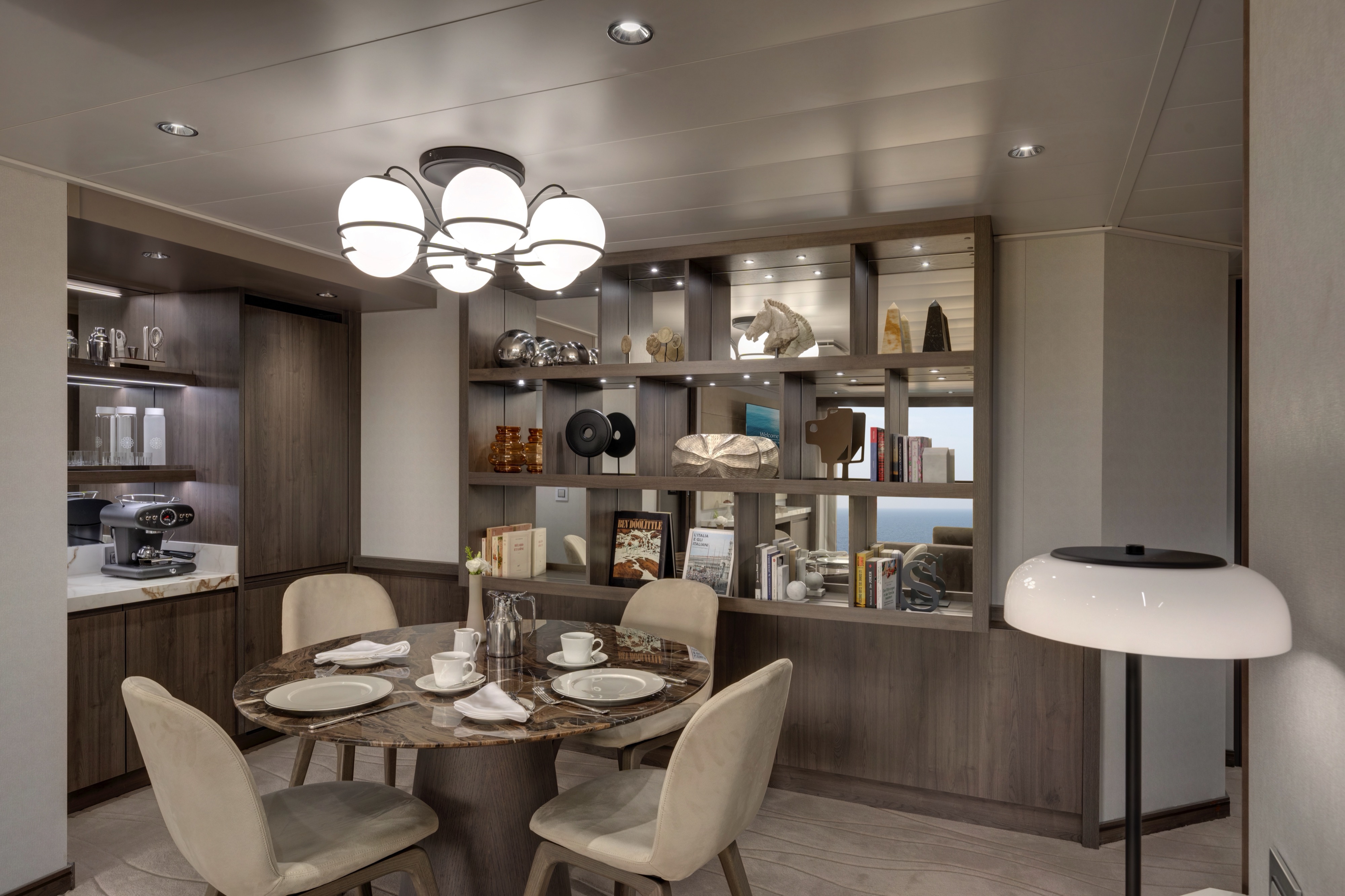

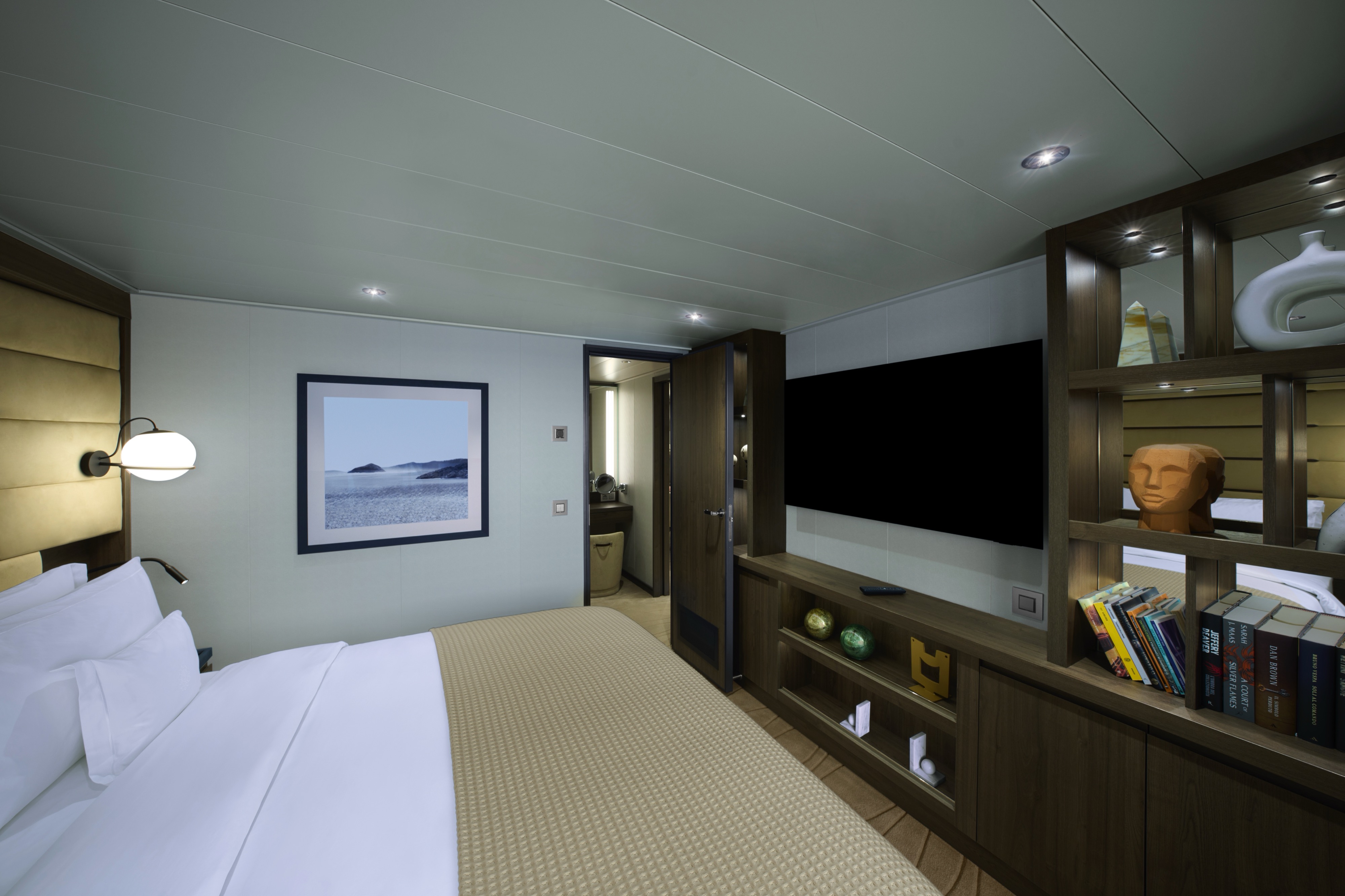

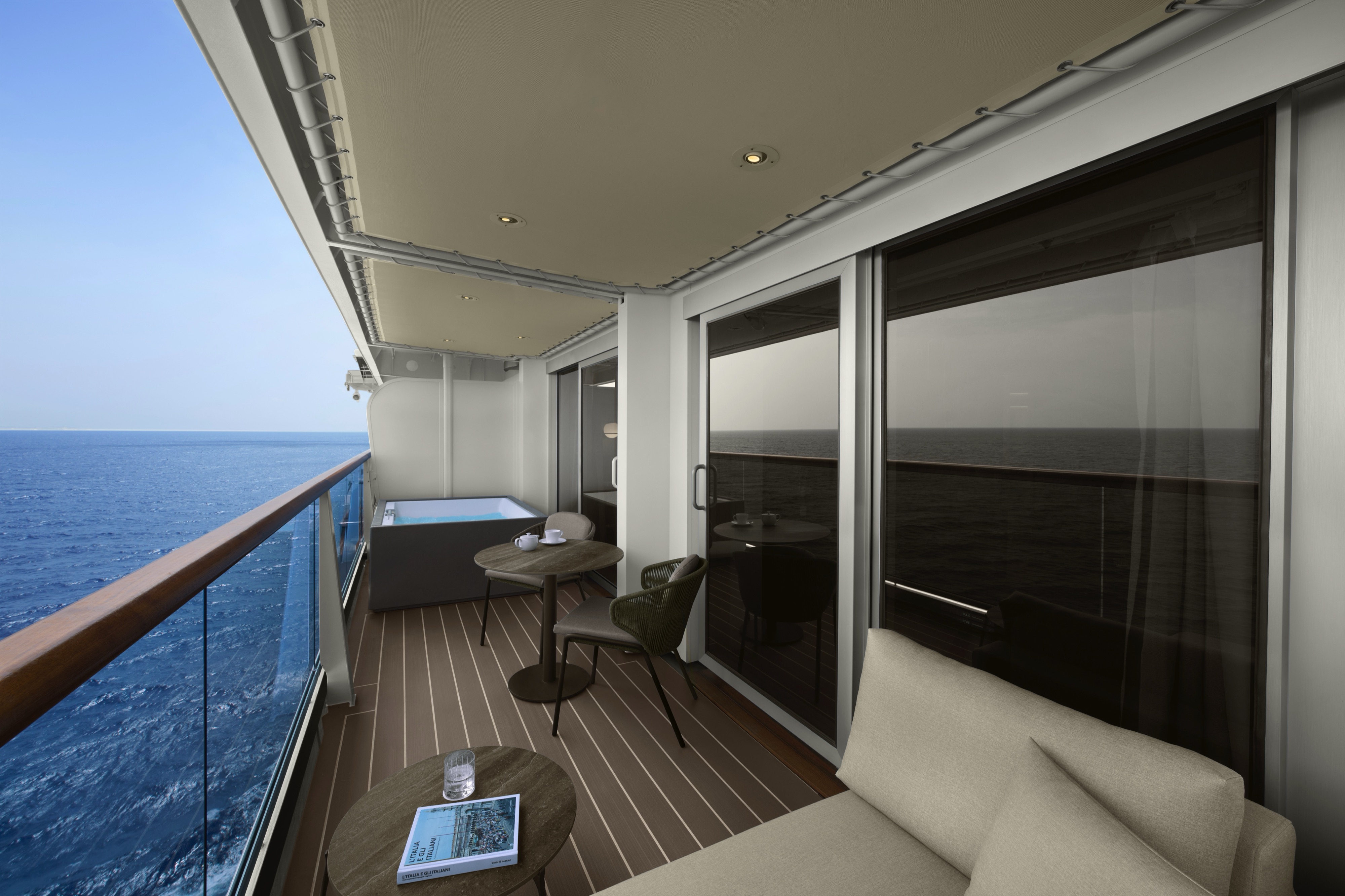

Abundant in space and light, the elegant Serenity Residences offer a large living area, a dining area for six, an adept desk area, a luxurious marble bathroom with a bathtub and separate shower, and a Residence Host providing butler services.
Features
- Private butler services from our Residence Hosts
- Oversized floor-to-ceiling windows with views of the sea
- Separate living, dining and sleeping areas
- Spacious lounge area
- Dining table for 4 guests
- Spacious work desk area
- In-suite welcome bottle of champagne
- Private refrigerated mini-bar, replenished according to the guests’ preferences from a selection of alcoholic and non-alcoholic beverages
- Cocktail making set
- Espresso machine, kettle and tea pot with a complimentary selection of coffee and teas
- Complimentary personal refillable water bottle for each guest
- Pair of binoculars for guests' use during their journey
- Technogym Bench and Technogym Case Kit for an efficient in-suite fitness experience
- Laptop-size safe
Outdoor
- Panoramic ocean-front terrace with private outdoor whirlpool, a dining table, a daybed and sun loungers
Bedroom
- Bespoke king-sized bed sleep system - size: 180 x 200 cm (71 x 79 in)
- Featuring a double sofa bed
- Fine bed linens
- Down duvets and pillows
- Extensive pillow selection
- Oversized walk-in wardrobe with a seated vanity area
Bathroom
- Luxurious marble bathroom with a bathtub, a separate walk-in shower room and heated floors
- Plush bathrobes and bath linens
- Custom bath toiletries and amenities
- Dyson Supersonic TM hairdryer and illuminated make-up/shaving mirror
Stats
- Total Suite Area: 113 sqm (1,216 sq ft) on deck 7 / 126 sqm (1,356 sq ft) on deck 9
- Suite: 60 sqm (646 sq ft)
- Terrace: 53 sqm (570 sq ft) on deck 7 / 66 sqm (710 sq ft) on deck 9
- Maximum capacity: 3 adults or 2 adults and 2 children under 18 years old (baby cot or double sofa bed)
*All images are a combination of photography and artist renderings.
The artist representations and interior decorations, finishes, and furnishings are provided for illustrative purposes only.












Our Cocoon Residences are amongst the most spacious of our residences, with an expansive sun terrace on the ship’s coveted aft deck.
Features
- Private butler services from our Residence Hosts
- Oversized windows with views of the sea
- Separate living, dining and sleeping areas
- Abundant lounge area
- Dining table for 4 guests
- Spacious work desk area
- In-suite welcome bottle of champagne
- Private refrigerated mini-bar, replenished according to the guests’ preferences from a selection of alcoholic and non-alcoholic beverages
- Cocktail making set
- Espresso machine, kettle and tea pot with a complimentary selection of coffee and teas
- Complimentary personal refillable water bottle for each guest
- Pair of binoculars for guests' use during their journey
- Technogym Bench and Technogym Case Kit for an efficient in-suite fitness experience
- Laptop-size safe
Outdoor
- Panoramic ocean-front terrace, with private outdoor whirlpool, a dining table, a scenic lounge area and sun loungers
Bedroom
- Bespoke king-sized bed sleep system - size: 200 x 200 cm (79 x 79 in)
- Featuring a double sofa bed
- Fine bed linens
- Down duvets and pillows
- Extensive pillow selection
- Oversized walk-in wardrobe with a seated vanity area
Bathroom
- Luxurious marble bathroom with a bathtub, a separate walk-in shower room and heated floors
- Plush bathrobes and bath linens
- Custom bath toiletries and amenities
- Dyson Supersonic TM hairdryer and illuminated make-up/shaving mirror
- Additional guest powder room
Stats
- Total Suite Area: 149 sqm (1,604 sq ft)
- Suite: 74 sqm (797 sq ft)
- Terrace: 75 sqm (807 sq ft)
- Maximum capacity: 3 adults or 2 adults and 2 children under 18 years old (baby cot or double sofa bed)
*All images are a combination of photography and artist renderings.
The artist representations and interior decorations, finishes, and furnishings are provided for illustrative purposes only.


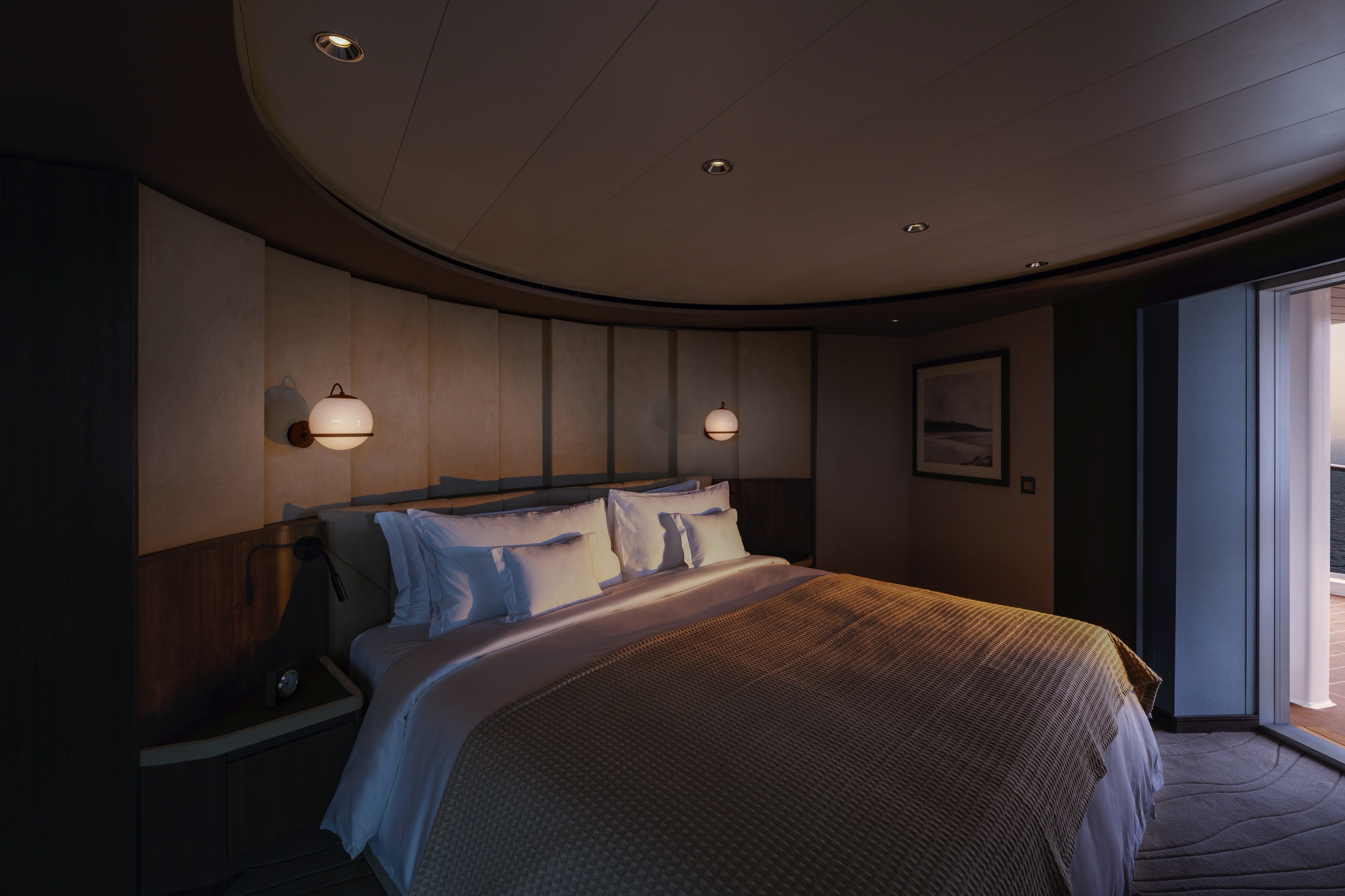



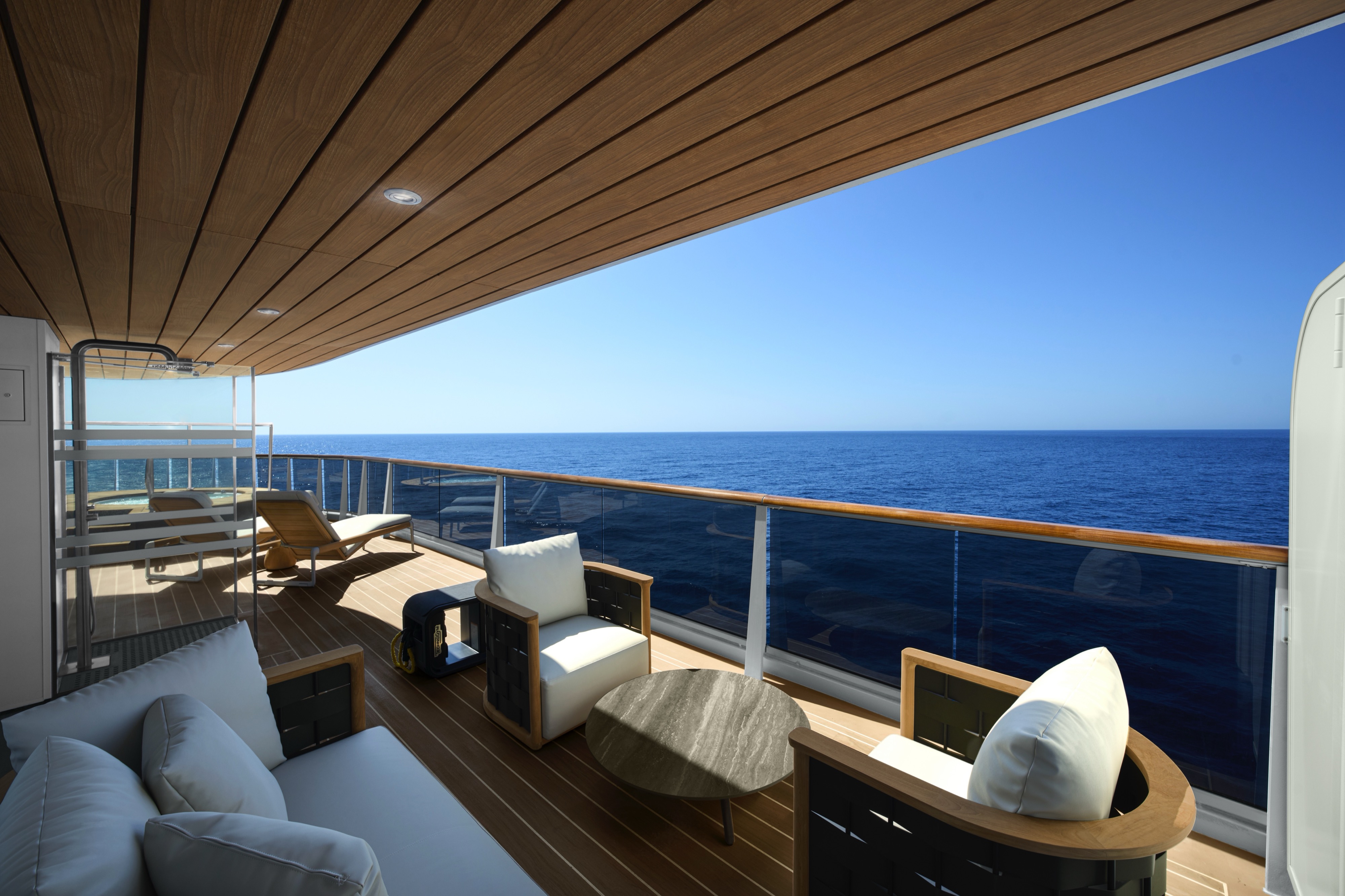

The most spacious of our penthouses, the Grand Penthouses offer elegant spaces with a separate stylish living area, a neat work space and a separate dining area for four, whilst the private sun terraces allow guests to unwind and savour the ocean, in the company of friends or one another.
Features
- Oversized floor-to-ceiling windows with views of the sea
- Separate living, dining and sleeping areas
- Spacious lounge area
- Dining table for 4 guests
- Spacious work desk area
- In-suite welcome bottle of champagne
- Private refrigerated mini-bar, replenished according to the guests’ preferences from a selection of alcoholic and non-alcoholic beverages
- Espresso machine, kettle and tea pot with a complimentary selection of coffee and teas
- Complimentary personal refillable water bottle for each guest
- Pair of binoculars for guests' use during their journey
- Technogym Case Kit with a smart range of fitness gear
- Safe accommodating most tablets and laptops
Outdoor
- Spacious ocean-front terrace with a dining area
- Comfortable daybed for relaxation
Bedroom
- Bespoke king-sized bed sleep system - size: 180 x 200 cm (71 x 79 in)
- Featuring a double sofa bed
- Fine bed linens
- Down duvets and pillows
- Extensive pillow selection
- Spacious walk-in wardrobe with a seated vanity area
Bathroom
- Spacious bathroom with a walk-in shower and heated floors
- Plush bathrobes and bath linens
- Custom bath toiletries and amenities
- Dyson Supersonic TM hairdryer and illuminated make-up/shaving mirror
Stats
- Total Suite Area: 60 sqm (646 sq ft) on decks 7, 8, 9, 10 / 68 sqm (732 sq ft) on deck 6
- Suite: 47 sqm (506 sq ft)
- Terrace: 13 sqm (140 sq ft) on decks 7, 8, 9, 10 / 21 sqm (226 sq ft) on deck 6 Maximum capacity: 3 adults or 2 adults and 2 children under 18 years old (baby cot or double sofa bed)
*All images are a combination of photography and artist renderings.
The artist representations and interior decorations, finishes, and furnishings are provided for illustrative purposes only.
Some suites feature bathtubs and accessible facilities:
Grand Penthouse Accessibility Features
- Roll-in shower with grab-bar and fold-down seat (height of seat from the floor is 450 mm / 17.7 in)
- Grab-bar next to the toilet seat
- Portable toilet seat risers available onboard
- Hand-held shower wand
- Lowered towel racks
- Accessibility equipment for hearing impaired (Assistive Listening System (ALS) and/or TTY devices)
- Lowered wardrobe bars and shelving
- Lowered safe
- Double peephole on entrance door
- All doorways are wheelchair accessible
- Entrance door width 900 mm (31.5 in)
- Bathroom door width 900 mm (31.5 in)
Accessible Grand Penthouse Stats
- Deck: 9 - Middle, close to lifts
- Number of Suites: 1 Total
- Suite Area: 60 sqm – 646 sq ft
- Suite: 47 sqm – 506 sq ft
- Terrace: 13 sqm – 140 sq ft
*Features may vary by suite.
Please inform your Travel Advisor or the Explora Experience Centre Ambassador of your requirements when reserving your journey.
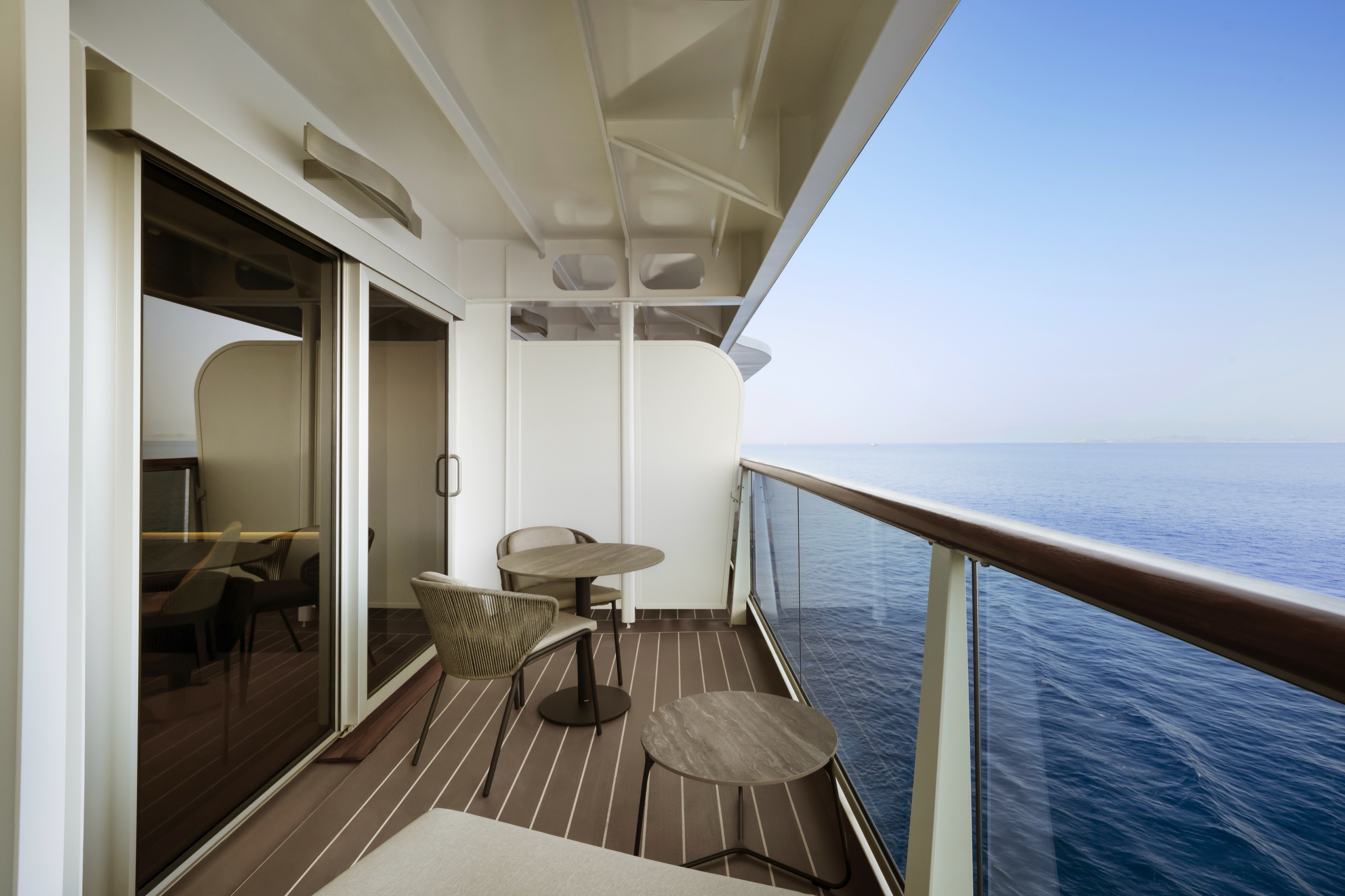





These light-filled, luxurious Premier Penthouses are designed for withdrawing in style or entertaining other guests – at a dining table laid for four, in the stylish living area and on the private sun terrace with a second seating area and daybeds or sunbeds overlooking the ocean.
Features
- Oversized floor-to-ceiling windows with views of the sea
- Separate living, dining and sleeping areas
- Spacious lounge area
- Dining table for 4 guests
- In-suite welcome bottle of champagne
- Private refrigerated mini-bar, replenished according to the guests’ preferences from a selection of alcoholic and non-alcoholic beverages
- Espresso machine, kettle and tea pot with a complimentary selection of coffee and teas
- Complimentary personal refillable water bottle for each guest
- Pair of binoculars for guests' use during their journey
- Technogym Case Kit with a smart range of fitness gear
- Safe accommodating most tablets and laptops
Outdoor
- Spacious ocean-front terrace with a dining area
- Comfortable daybed for relaxation
Bedroom
- Bespoke king-sized bed sleep system - size: 180 x 200 cm (71 x 79 in)
- Some suites feature a double sofa bed
- Down duvets and pillows
- Fine bed linens
- Extensive pillow selection
- Spacious walk-in wardrobe with a seated vanity area
Bathroom
- Spacious bathroom with a walk-in shower and heated floors
- Plush bathrobes and bath linens
- Custom bath toiletries and amenities
- Dyson Supersonic TM hairdryer and illuminated make-up/shaving mirror
Stats
- Total Suite Area: 52 sqm (560 sq ft)
- Suite: 42 sqm (452 sq ft)
- Terrace: 10 sqm (108 sq ft)
- Maximum capacity: 3 adults or 2 adults and 1 child under 18 years old (baby cot, double sofa bed or rollaway bed)
*All images are a combination of photography and artist renderings.
The artist representations and interior decorations, finishes, and furnishings are provided for illustrative purposes only.



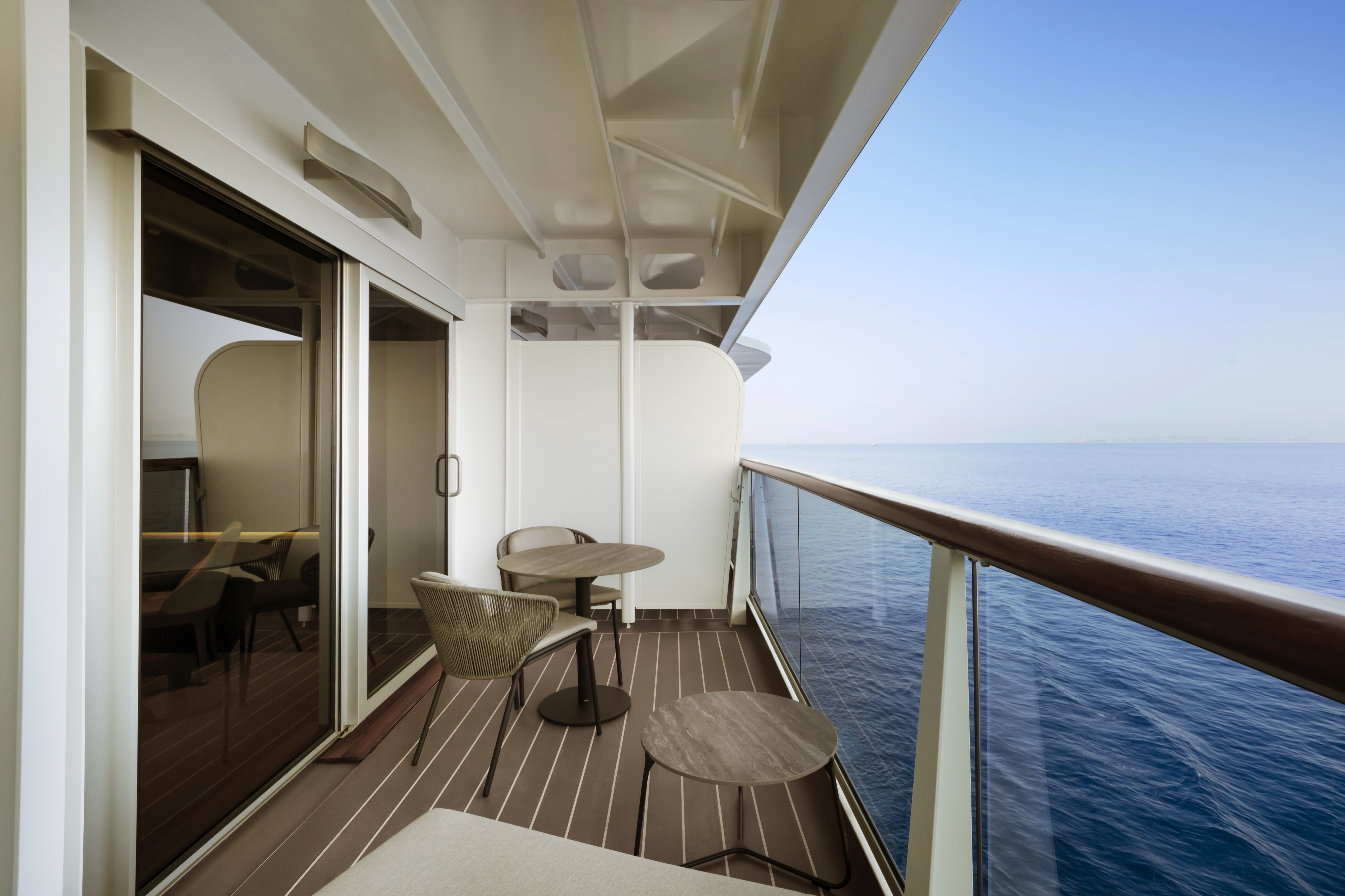
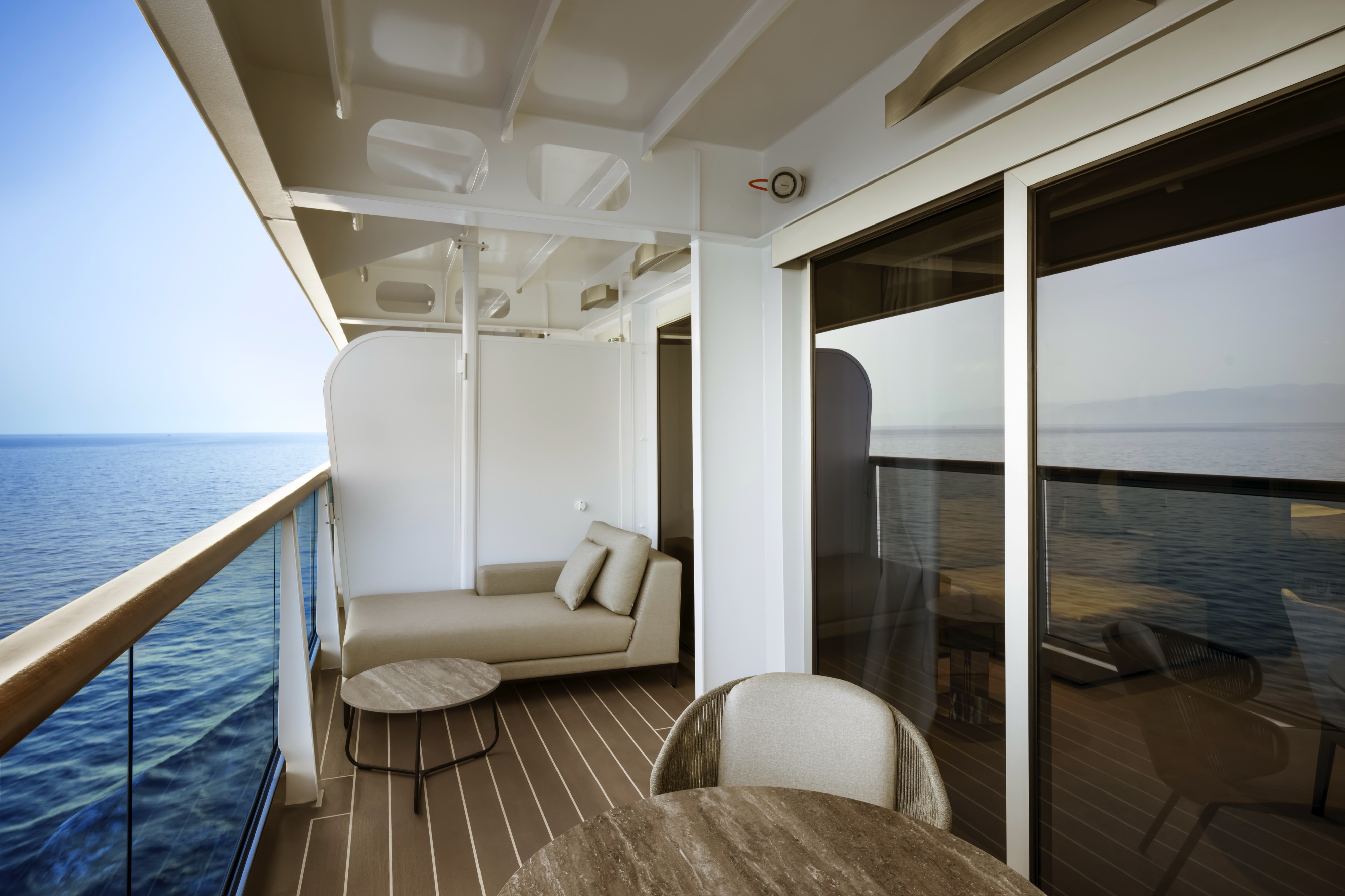
Flooded with light from the floor-to-ceiling oversized windows, the Deluxe Penthouses offer elegant accommodation and a stylish living area, a neat work space and a separate dining area for four.
Features
- Oversized floor-to-ceiling windows with views of the sea
- Spacious lounge area
- Dining table for 4 guests
- Some suites feature a spacious work desk area
- In-suite welcome bottle of champagne
- Private refrigerated mini-bar, replenished according to the guests’ preferences from a selection of alcoholic and non-alcoholic beverages
- Espresso machine, kettle and tea pot with a complimentary selection of coffee and teas
- Complimentary personal refillable water bottle for each guest
- Pair of binoculars for guests' use during their journey
- Technogym Case Kit with a smart range of fitness gear
- Safe accommodating most tablets and laptops
Outdoor
- Spacious ocean-front terrace with a dining area
- Comfortable daybed or lounge chairs for relaxation
Bedroom
- Bespoke king-sized bed sleep system - size: 180 x 200 cm (71 x 79 in)
- Down duvets and pillows
- Fine bed linens
- Extensive pillow selection
- Spacious walk-in wardrobe with a seated vanity area
Bathroom
- Spacious bathroom with a walk-in shower and heated floors
- Plush bathrobes and bath linens
- Custom bath toiletries and amenities
- Dyson Supersonic TM hairdryer and illuminated make-up/shaving mirror
* Some suites feature bathtubs
Stats
- Total Suite Area: 48 sqm (517 sq ft) on decks 9, 10 / 53 sqm (570 sq ft) on deck 6 / 61 sqm (657 sq ft) on deck 7
- Suite: 38 sqm (409 sq ft) on decks 9, 10 / 43 sqm (463 sq ft) on decks 6, 7
- Terrace: 10 sqm (108 sq ft) on decks 6, 9, 10 / 18 sqm (194 sq ft) on deck 7 Maximum capacity: 3 adults or 2 adults and 1 child under 18 years old (baby cot, double sofa bed or rollaway bed)
*All images are a combination of photography and artist renderings.
The artist representations and interior decorations, finishes, and furnishings are provided for illustrative purposes only.


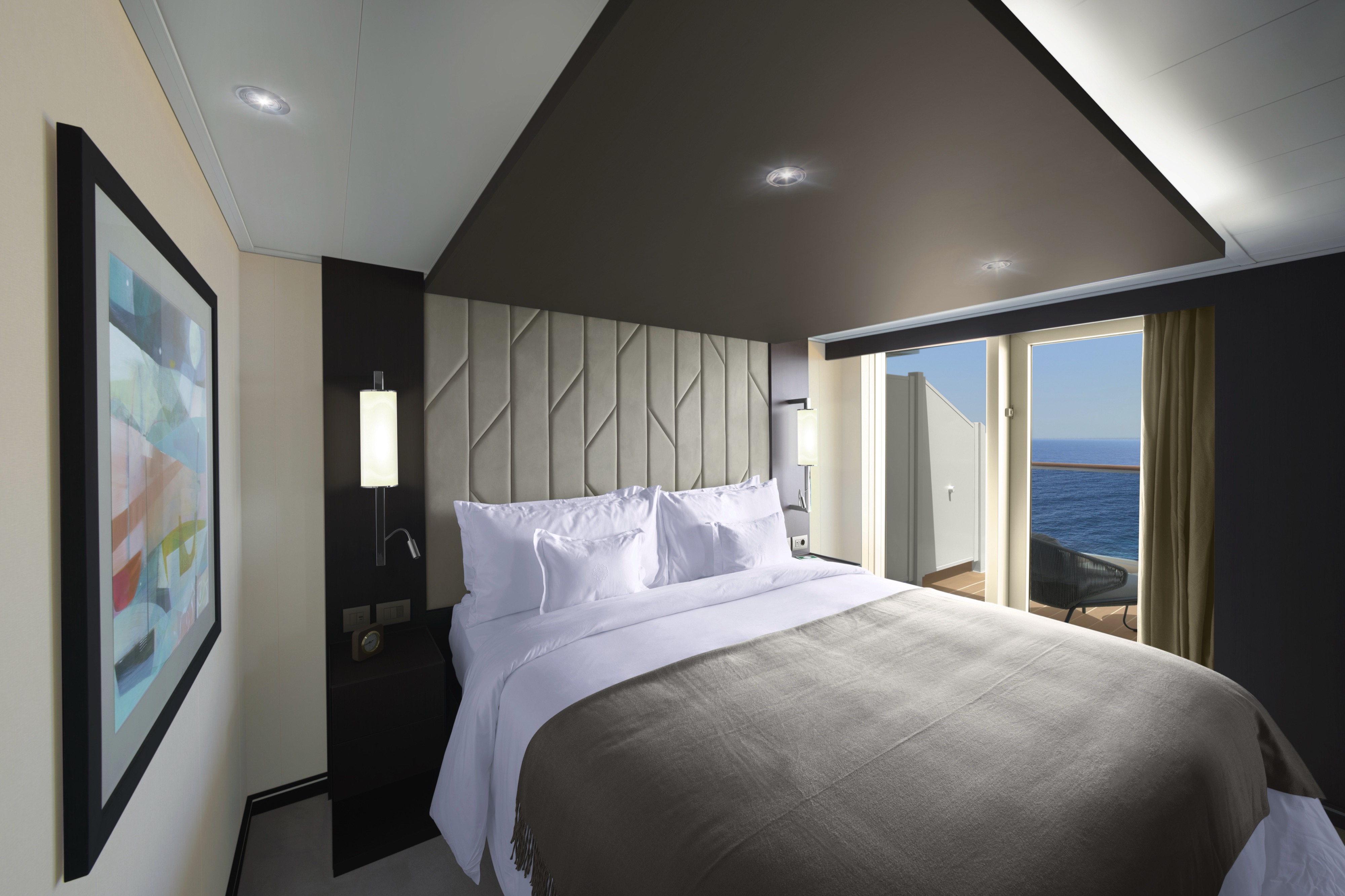



Each of our Penthouses offers a spacious living area, a neat work space and a separate dining area for four, allowing guests to entertain others or retreat in style as they see fit.
Features
- Oversized floor-to-ceiling windows with views of the sea
- Spacious lounge area
- Dining table for 4 guests
- In-suite welcome bottle of champagne
- Private refrigerated mini-bar, replenished according to the guests’ preferences from a selection of alcoholic and non-alcoholic beverages
- Espresso machine, kettle and tea pot with a complimentary selection of coffee and teas
- Complimentary personal refillable water bottle for each guest
- Pair of binoculars for guests' use during their journey
- Technogym Case Kit with a smart range of fitness gear
- Safe accommodating most tablets and laptops
Outdoor
- Spacious ocean-front terrace with a dining area
- Comfortable daybed for relaxation
Bedroom
- Bespoke king-sized bed sleep system - size: 180 x 200 cm (71 x 79 in)
- Down duvets and pillows
- Fine bed linens
- Extensive pillow selection
- Spacious walk-in wardrobe with a seated vanity area
Bathroom
- Spacious bathroom with a walk-in shower and heated floors
- Plush bathrobes and bath linens
- Custom bath toiletries and amenities
- Dyson Supersonic TM hairdryer and illuminated make-up/shaving mirror
Stats
- Total Suite Area: 43 sqm (463 sq ft) on decks 7, 8, 9 / 48 sqm (517 sq ft) on deck 6
- Suite: 34 sqm (366 sq ft)
- Terrace: 9 sqm (97 sq ft) on decks 7, 8, 9 / 14 sqm (151 sq ft) on deck 6
- Maximum capacity: 3 adults or 2 adults and 1 child under 18 years old (baby cot, double sofa bed or rollaway bed)
*All images are a combination of photography and artist renderings.
The artist representations and interior decorations, finishes, and furnishings are provided for illustrative purposes only.

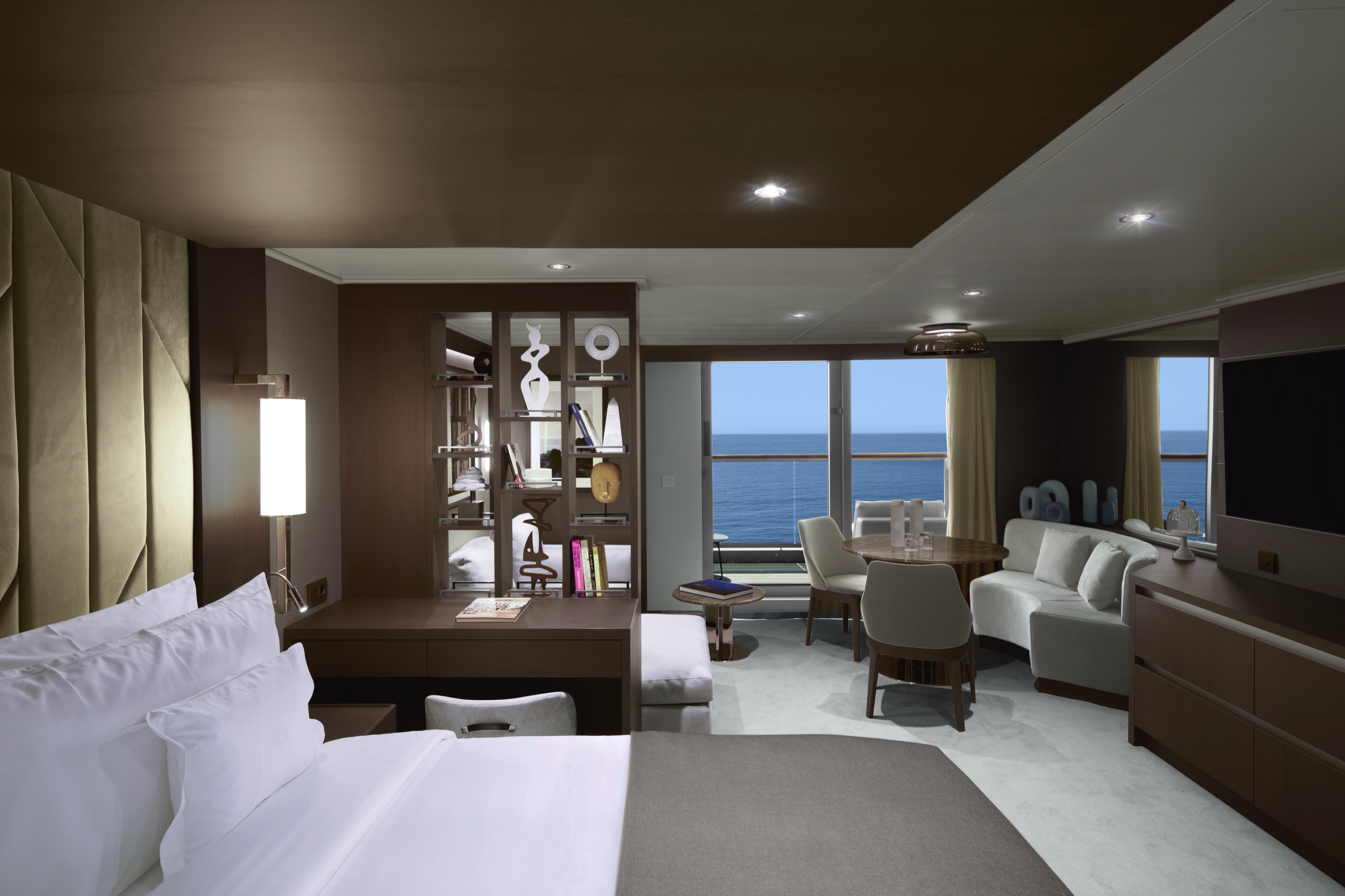
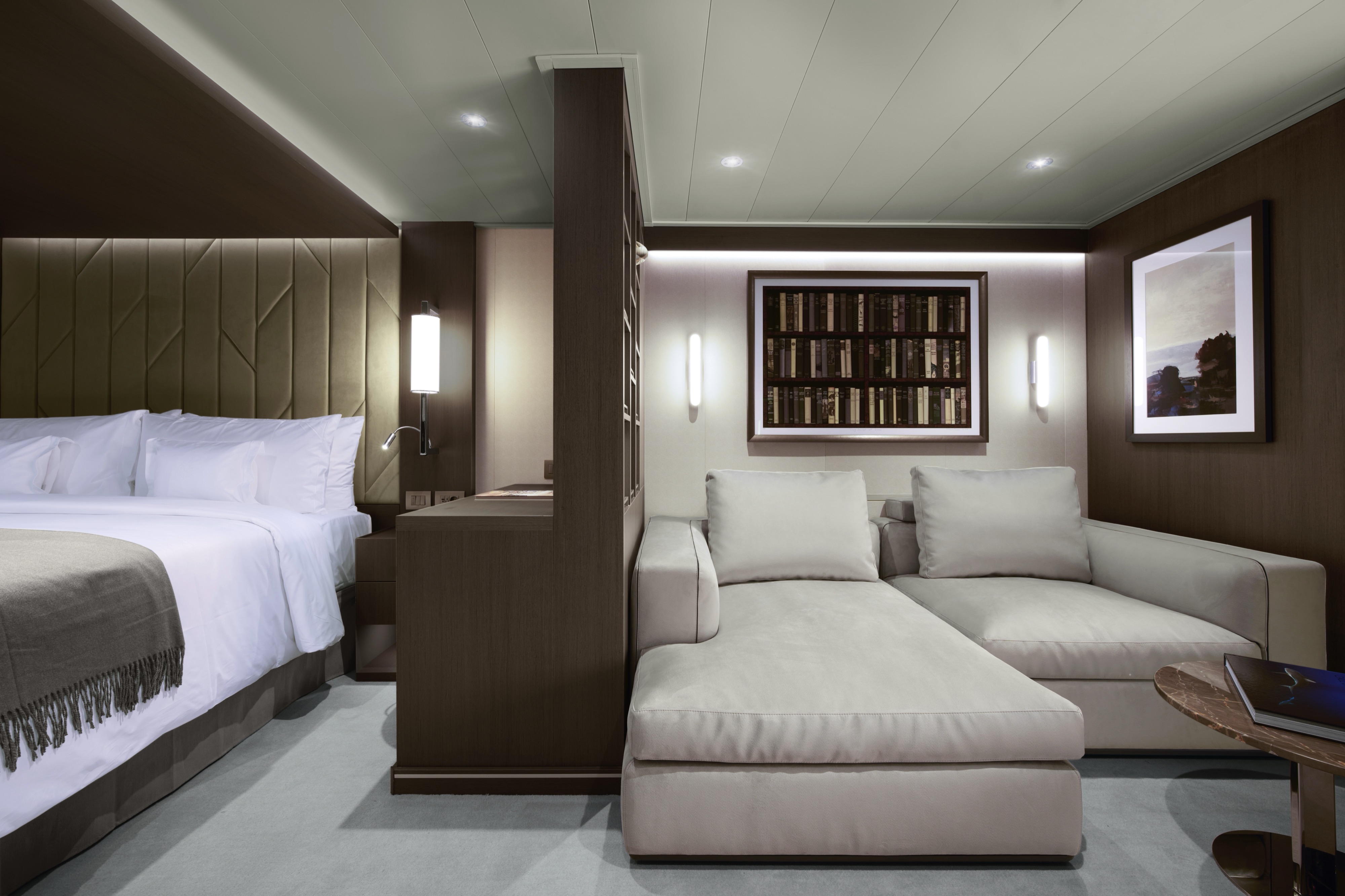






Our Ocean Grand Terrace Suites offer a more spacious private sun terrace, allowing guests to savour the ocean from the comfort of their daybed.
Features
- Oversized floor-to-ceiling windows with views of the sea
- Lounge area with coffee/dining table
- In-suite welcome bottle of champagne
- Private refrigerated mini-bar, replenished according to the guests’ preferences from a selection of alcoholic and non-alcoholic beverages
- Espresso machine, kettle and tea pot with a complimentary selection of coffee and teas
- Complimentary personal refillable water bottle for each guest
- Pair of binoculars for guests' use during their journey
- Safe accommodating most tablets and laptops
Outdoor
- Spacious ocean-front terrace with a dining area
- Comfortable daybed for relaxation
Bedroom
- Bespoke king-sized bed sleep system - size: 180 x 200 cm (71 x 79 in). Some suites with twin beds - size: 2 x 90 x 200 cm (35 x 79 in)
- Down duvets and pillows
- Fine bed linens
- Extensive pillow selection
- Spacious walk-in wardrobe with a seated vanity area
Bathroom
- Spacious bathroom with a walk-in shower and heated floors
- Plush bathrobes and bath linens
- Custom bath toiletries and amenities
- Dyson Supersonic TM hairdryer and illuminated make-up/shaving mirror
- Total Suite area: 39 sqm (420 sq ft)
- Suite: 28 sqm (301 sq ft)
- Bathroom: 4 sqm (43 sq ft)
- Terrace: 11 sqm (118 sq ft)
- Maximum capacity: 2 adults and 1 child under 18 years old (baby cot or rollaway bed) Decks: 6, 7 - Aft, Middle and Forward Number of suites: 70
*All images are a combination of photography and artist renderings.
The artist representations and interior decorations, finishes, and furnishings are provided for illustrative purposes only.



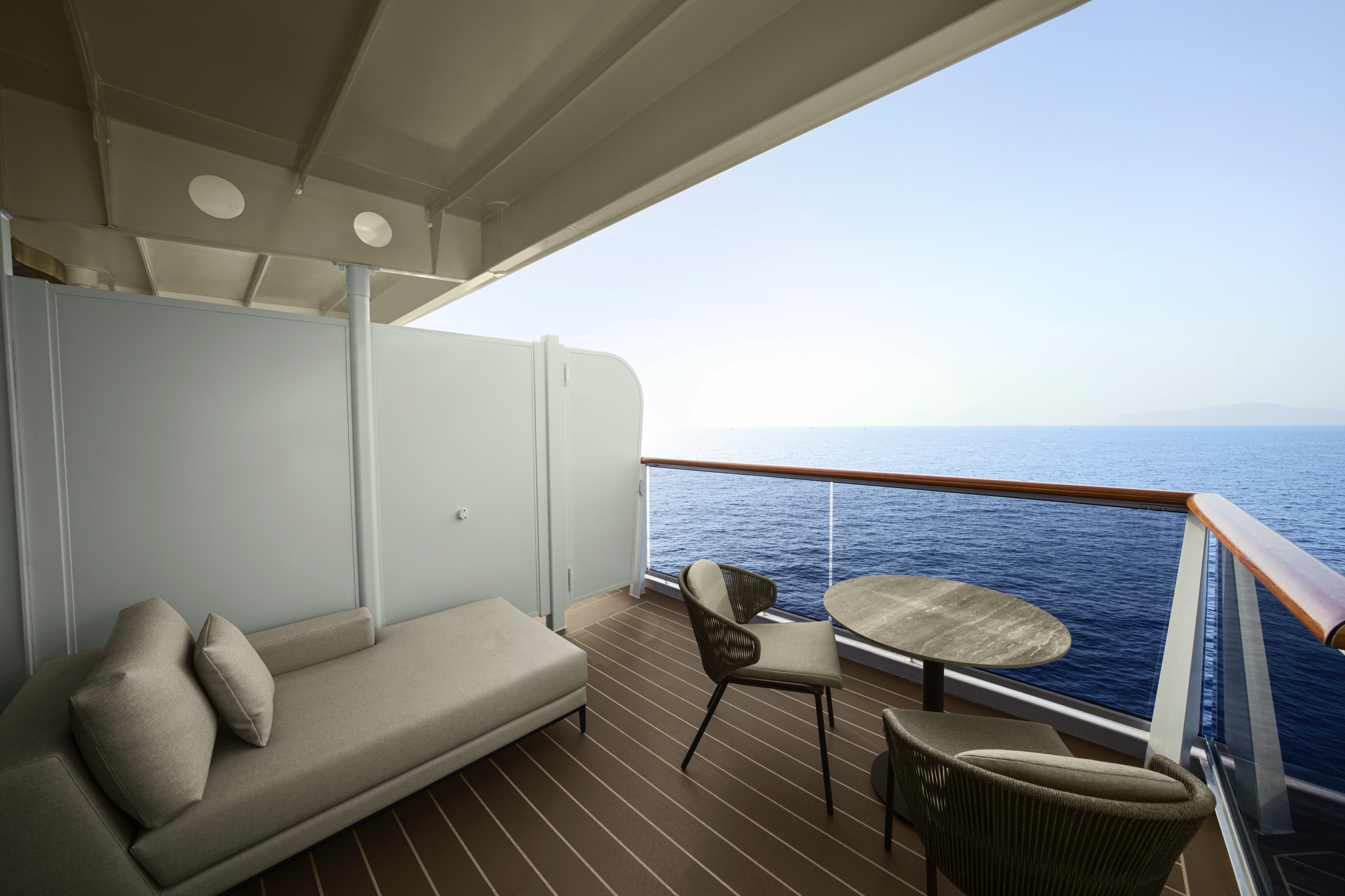

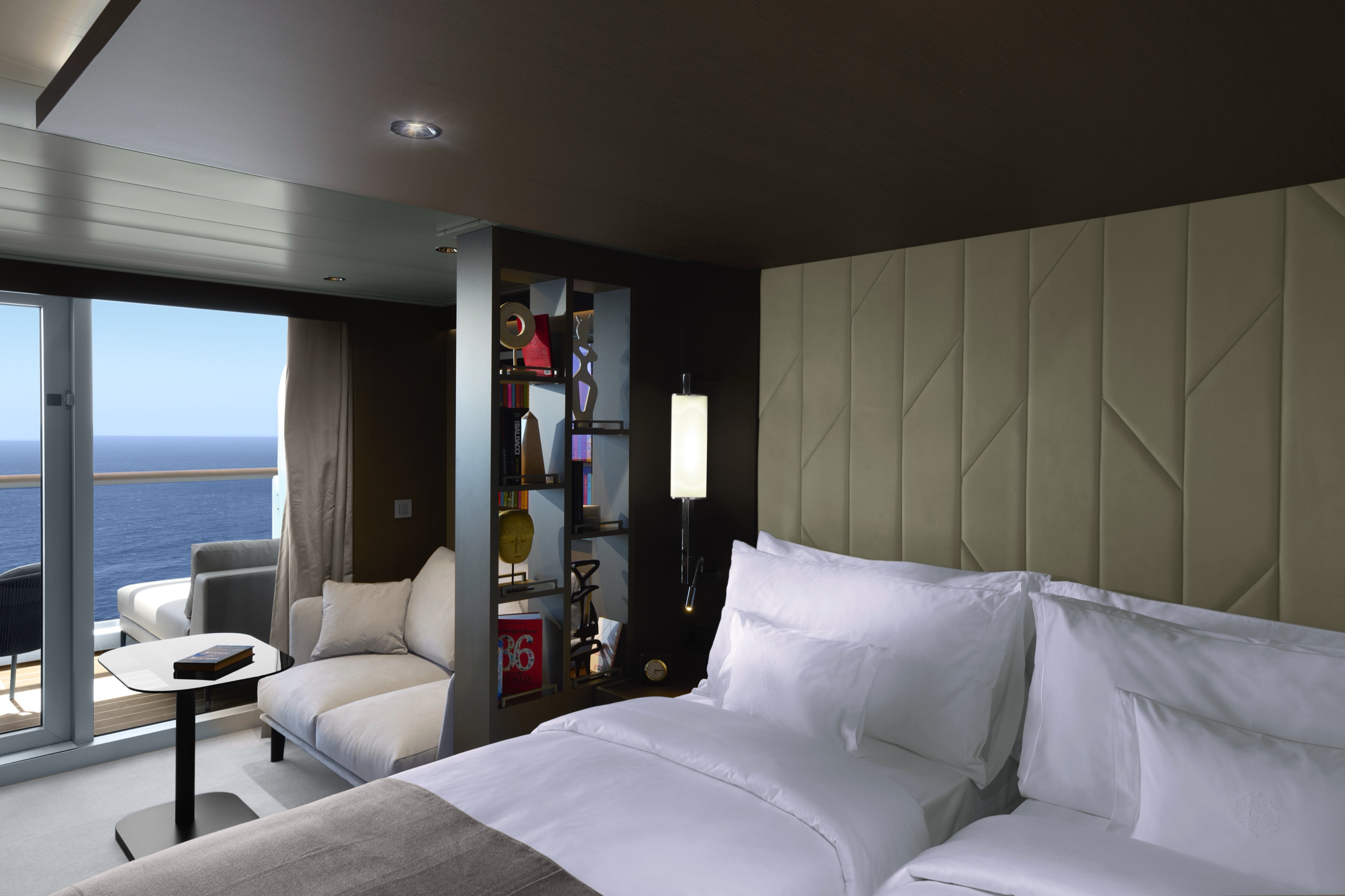


Our Ocean Terrace Suites elegantly combine space and light.
Features
- Oversized floor-to-ceiling windows with views of the sea
- Lounge area with coffee/dining table
- In-suite welcome bottle of champagne
- Private refrigerated mini-bar, replenished according to the guests’ preferences from a selection of alcoholic and non-alcoholic beverages
- Espresso machine, kettle and tea pot with a complimentary selection of coffee and teas
- Complimentary personal refillable water bottle for each guest
- Pair of binoculars for guests' use during their journey
- Safe accommodating most tablets and laptops
Outdoor
- Spacious ocean-front terrace with a dining area
- Comfortable daybed for relaxation
Bedroom
- Bespoke king-sized bed sleep system - size: 180 x 200 cm (71 x 79 in). Some suites with twin beds - size: 2 x 90 x 200 cm (35 x 79 in)
- Down duvets and pillows
- Fine bed linens
- Extensive pillow selection
- Spacious walk-in wardrobe with a seated vanity area
Bathroom
- Spacious bathroom with a walk-in shower and heated floors
- Plush bathrobes and bath linens
- Custom bath toiletries and amenities
- Dyson Supersonic TM hairdryer and illuminated make-up/shaving mirror
Stats
- Total Suite area: 35 sqm (377 sq ft)
- Suite: 28 sqm (301 sq ft)
- Bathroom: 4 sqm (43 sq ft)
- Terrace: 7 sqm (75 sq ft)
- Maximum capacity: 2 adults and 1 child under 18 years old (baby cot or rollaway bed)
*All images are a combination of photography and artist renderings.
The artist representations and interior decorations, finishes, and furnishings are provided for illustrative purposes only.
Some suites feature bathtubs and accessible facilities:
Ocean Terrace Suite Accessibility Features
- Roll-in shower with grab-bar and fold-down seat (height of seat from the floor is 450 mm / 17.7 in)
- Grab-bar next to the toilet seat
- Portable toilet seat risers available onboard
- Hand-held shower wand
- Lowered towel racks
- Accessibility equipment for hearing impaired (Assistive Listening System (ALS) and/or TTY devices)
- Lowered wardrobe bars and shelving
- Lowered safe
- Double peephole on entrance door
- All doorways are wheelchair accessible
- Entrance door width 900 mm (31.5 in)
- Bathroom door width 900 mm (31.5 in)
Stats
- Deck 8, 9, 10 - Forward, close to lifts
- Number of Suites OT2 - 4, OT3 - 4, OT4 - 1
- Total Suite Area: 49 sqm – 526 sq ft
- Suite: 39 sqm – 419 sq ft
- Terrace: 10 sqm – 107 sq ft
*Features may vary by suite.
Please inform your Travel Advisor or the Explora Experience Centre Ambassador of your requirements when reserving your journey.








EXPLORA I
A new era of ocean travel has arrived.
On 1 August 2023, EXPLORA I departed on her Maiden Journey, sailing from Copenhagen, Denmark on an epic 14-night journey through seven captivating destinations with a two-night stay in Reykjavik, before returning to the Danish capital.
This marks the start of a series of itineraries spanning three continents, offering guests cultural immersion and an opportunity for inner and outer discovery on their quest to the Ocean State of Mind.

Ship Facts
| Speed | N/A | ||||||
| Width | 32 | ||||||
| Length | 248 | ||||||
| Capacity | N/A | ||||||
| Currency | EUR | ||||||
| Language | en | ||||||
| Crew Count | N/A | ||||||
| Deck Count | 11 | ||||||
| Refit Year | |||||||
| Cabin Count | 461 | ||||||
| Launch Year | 2023 | ||||||
| Gross Tonnage | 63900 | ||||||
| Electrical Plugs |
| ||||||
| Large Cabin Count | N/A | ||||||
| Wheelchair Cabin Count | N/A |
Deck 14
- Sports Court
- Whirlpool
- Panorama Lounge
- Sky Bar On 14

Deck 12
- Helios Pool & Lounge (Adults Only)
- Running Track
- Whirlpools
- Lift

Deck 11
- Explora Lounge
- Private Dining Room
- Malt Whiskey Bar
- Chef's Kitchen
- Children & Teens Area
- The Conservatory Pool & Bar
- Indoor Whirlpool
- Gelateria & Creperie
- Emporium Marketplace Restaurant
- Emporium Marketplace Restaurant Outdoor Seating
- Lift

Deck 10
- Ocean Wellness Fitness Centre
- Atoll Pool & Bar
- Upper Aft Pool & Lounge
- Grand Penthouse
- Deluxe Penthouse
- Cove Residence
- Premier Penthouse
- Ocean Terrace Suite
- Lift

Deck 9
- Retreat Residence
- Ocean Terrace Suite
- Cove Residence
- Grand Penthouse
- Premier Penthouse
- Deluxe Penthouse
- Penthouse
- Serenity Residence
- Lift

Deck 8
- Owner's Residence
- Retreat Residence
- Ocean Terrace Suite
- Penthouse
- Premier Penthouse
- Grand Penthouse
- Cove Residence
- Lift

Deck 7
- Retreat Residence
- Ocean Grand Terrace Suite
- Ocean Terrace Suite
- Grand Penthouse
- Cove Residence
- Deluxe Penthouse
- Penthouse
- Serenity Residence
- Lift

Deck 6
- Cocoon Residence
- Penthouse
- Deluxe Penthouse
- Ocean Grand Terrace Suite
- Ocean Terrace Suite
- Grand Penthouse
- Cove Residence
- Lift

Deck 5
- Ocean Wellness The Spa
- Future Journeys Ambassadors
- Anthology Restaurant
- Crema Café
- Marble & Co. Grill Restaurant
- Galleria D'Arte
- MSC Foundation
- Astern Lounge
- Sakura Restaurant
- Astern Pool & Bar
- Lift

Deck 4
- Journeys Lounge
- The Casino
- Guest Services
- Destination Experiences
- Shops
- Lobby & Lobby Bar
- Med Yacht Club Restaurant
- Fil Rouge Restaurant
- Lift

Deck 3
- Medical Centre
- Marina Lounge
- Marina Deck

Passion For Authenticity, Provenance And Wholesome Ingredients
Worldly, sophisticated, and well-travelled, with European panache, our culinary and beverage experts bring together an abundance of experience and artistry to the curation of immersive dining experiences. Our team brings enthusiasm for provenance along with a plethora of stories about the rare ingredients, which are hand-selected just for Explora Journeys.
Throughout the year, wine selections will reflect the regional areas where the ship sails, while offering favourite grape varietals including French Chenin Blanc, Pinot Grigio, New Zealand Sauvignon Blanc, Australian Shiraz, and Nebbiolo. Sommeliers will constantly source boutique wine labels to build an inspiring menu with truly interesting choices and very rare bottles.
To ensure your place at one of our enticing restaurants, send an email to your Travel Ambassador as you get ready for your upcoming journey. You can make reservations up to 60 days before your departure.
Anthology
A Gastronomic Adventure
As our signature fine-dining experience, Anthology elevates Italian cuisine, offering an unparalleled gastronomic adventure.
On the menu, created by our esteemed Head of Culinary, Franck Garanger, each dish is a celebration of Italy’s finest regional ingredients and flavours.From the renowned flavours of Piedmont’s truffle-rich countryside in the North, to the famed specialities of Italy’s South, each plate celebrates the local produce and time-honoured techniques of every region in Italy.
The menu is an ingenious display of creativity – a vibrant tapestry of regional flavours and authentic ingredients which invites guests to immerse themselves in the different styles and tastes of Italy’s universally loved cuisine.
Contemporary, Refined Elegance
With the opportunity to dine outdoors, Anthology offers an intimate yet elevated dining atmosphere with flawless, attentive service.
- Indoor seating: 48
- Outdoor seating: 22
- Open for dinner
- Reservations recommended
- An Exclusive Experience Fee Applies
- Located on Deck 5
Sakura
An immersive, authentic dining experience offering the finest Pan-Asian cuisine.
Named after the cherry blossom - the national flower of Japan - and symbolic of renewal and optimism, Sakura offers Japanese, Thai, Vietnamese, and Malaysian flavours for a taste of Pan-Asian cuisine that is both authentic and energising.
The space takes inspiration from Japan’s rich cultural heritage of tradition and rituals blended with distinct Japanese design cues, to create an intimate and welcoming space. The ancient tea rooms of Kyoto provide the inspiration for Sakura, where dark wood frames lead your eye to traditional Japanese ceiling details, adorned with a cherry blossom tree canopy which shrouds diners with a warm atmosphere of festoon lights.
Authenticity extends to the kitchen, where chefs follow traditional techniques – using only the very best carefully sourced ingredients – to ensure a truly pan-Asian experience.
Expansive ocean views, a Sake sommelier, Asian-influenced beverages - including a curated selection of sakes and shōchū - combined with seamless service and modern Asian music create a dynamic dining experience.
Signature Dishes at Sakura
Wagyu beef tataki, wakame salad, smoked Madagascan pepper
Never cooked or grilled, our sustainably sourced prime grade 5 Japanese wagyu beef is delicately torched by our chefs: this authentic method of cooking ensures that the best qualities of the beef are preserved for the guests’ mouth-watering enjoyment.
Makrut lime pavlova, mango brunoise, passion fruit, mango sorbet
A fusion of east and west, this unique interpretation of pavlova is a perfect representation of the passionate, creative expertise and multicultural diversity of our talented pastry team .
Kale salad
Another example of our chefs’ ingenuity, a humble kale salad is transformed into culinary art for our guests to enjoy. This superfood salad is not simply dressed, but cured with the finest quality of sesame dressing for a rounded flavour - it represents a fusion of clean living with the flavours of Asia.
- Indoor seating: 92
- Outdoor seating: 26
- Open for lunch and dinner
- Reservations recommended
- The Sushi Bar is open-seating on a first come first served basis.
- Located on Deck 5
Marble & Co. Grill
Inspired by the marbling found in only the finest beef, Marble & Co. Grill serves exceptional cuts, personally sourced and sustainably farmed.
The menu has been designed to take guests on a journey of discovery, with sumptuous, rare meats sourced for their flavour and distinctive provenance. More than a steakhouse, Marble & Co is the realisation of a vision where careful attention to ingredients and passion for cooking come together to create a truly special dining experience.
This redefined European steakhouse experience is reflected through the modern, understated yet sophisticated design with soft lighting and relaxed, attentive service. The experience is augmented by an in-house dry ager and a cellar boasting a superb selection of fine wines.
Signature Dishes at Marble & Co. Grill
Grilled prime rib, aged 30-days, cherry tomatoes, Hollandaise sauce
Provenance and quality take centre stage, to create the finest version of a steakhouse classic. From a local producer in Deux Sévres region of the lush Loire Valleé, it’s clear why the famous Jersiaise breed, renowned for its sensational flavour and intense marbling, is one of the most sought-after cuts or prime rib. To truly appreciate this beautiful cut, it is topped simply with cherry tomatoes and a sumptuous Hollandaise sauce.
Crushed fingerling potatoes, Le Beurre Bordier butter from Normandy, Calvisius Oscietra caviar, crème fraîche, chives
A simple dish executed with the finest ingredients. The crushed fingerling potatoes are made with Bordier butter, arguably, the finest butter in the world, served only in the finest establishments. Potatoes are topped with Calvisius Oscietra caviar, known the world over for being some of the best quality caviar available; the caviar is sustainably produced in Italy, in an area rich with fresh spring water, contributing to its high quality and low-salt flavour.
- Indoor seating: 80
- Outdoor seating: 10
- Open for dinner
- Reservations recommended
- Located on Deck 5
Med Yacht Club
A relaxed celebration of the flavours, ambience and la dolce vita of the Mediterranean.
Inspired by sailings across crystal clear waters, the Med Yacht Club is influenced by sophisticated, beachside Mediterranean restaurants, embracing the varied cuisines of the region.
Effortlessly refined in its design, Med Yacht Club creates a relaxed, convivial atmosphere, where bright sunshine streaming through large portholes and Med-influenced music transport guests on a culinary journey inspired by sea travel.
Inspired by authentic Mediterranean dining, and infusing tastes and textures of Italy, Spain, Greece, France, and North Africa – while incorporating plant-based, vegetarian and wholesome ingredients – the menu of Med Yacht Club serves sharing plates, created with passion, for guests to enjoy with friends and family alike. Each dish is inspired by the most authentic of Mediterranean ingredients and flavours.
Wines will showcase the rich vineyards of the Mediterranean, with fresh juices and cocktails honouring regional ingredients.
Signature Dishes at Med Yacht Club
Grilled octopus, San Marzano tomato sauce, Taggiasca olives, green beans, parsley
If ever there were a singular dish to represent the importance province plays in the ingredients used onboard Explora Journeys, then this is surely it. Sharp sundried Taggiasca olives compliment the sweet San Marzano tomatoes, creating a perfectly balanced bed for the expertly grilled, sustainably sourced octopus.
Sweet caprese with cherry tomatoes, strawberries, burrata, pesto
A true representation of the creativity and skill of our chefs, this sweet interpretation of an Italian classic will surprise and delight in equal measure. The finest cherry tomatoes and strawberries create an intriguing base, upon which our burrata sits - made with emulsified burrata cream, and adorned with even more sweet tomatoes and strawberries with a drizzle of pesto from Sicilian Bronte pistachios.
- Indoor seating: 136 (34 at the bar)
- Open for lunch and dinner
- Located on Deck 4
Emporium Marketplace
An Emporium is defined as a place offering many different things, a place for merchants to showcase their best produce (coming from the Greek word emporion - ἐμπόριον).
Emporium Marketplace is an effortless all-day dining restaurant, bringing the global culinary talent and produce to the fore to offer diverse cuisines with a focus on quality produce, inspired by local destinations, and allowing guests total flexibility in what they choose to eat, and when.
Bathed in natural bright light, several separate cooking stations evolve throughout the day. White marble and minimalist design take centre stage, allowing the freshest ingredients to make the food the true hero of this elegant relaxed space.
Features include sushi, fresh seafood and a daily rotisserie offering grilled, roasted, and slow-cooked meats. Pasta is cooked to order, and freshly baked pizzas and bread are on offer as are home-made sandwiches. The charcuterie, fromagerie, boulangerie and patisserie stations enhance the experience. Fresh juices, smoothies and acai bowls are provided during breakfast.
A selection of wines, champagne and beverages are available to complement meals throughout the day.
Signature Dishes at Emporium Marketplace
Handmade tortelloni, ricotta cheese, spinach, tomato-sage butter
It’s often the simplest dishes that take great skill – this classic is no exception. Tortelloni are ring-shaped, filled pasta ‘pockets’ that originate in Italy’s Emilia-Romagna region. Made onboard from scratch every day in the authentic Italian way, it’s a process best described as art-meets-science. Carefully sourced flour is used to make dough that has the correct degree of elasticity; this is essential to giving the tortelloni their mouth-watering light and silky texture before being filled with ricotta and spinach, then gently coated in tomato-sage butter.
Plant based chia yoghurt
Our curated chia yoghurt is daily made from homemade cashew milk, creating a fusion of delicious creamy flavours for guests to enjoy each morning.
- Indoor seating: 271
- Outdoor seating: 70
- Open for breakfast, lunch and dinner
- Located on Deck 11
Fil Rouge
A global tasting tour to French-inspired international cuisine.
A common red thread that unites international flavours with a French influence. Fil Rouge is a sophisticated and intimate restaurant, offering a global tasting tour of French-inspired international cuisine, where guests are encouraged to take their time to appreciate both the cuisine and the intimate ambience.
A universal, timeless dining experience, Fil Rouge is a visual articulation of the fundamentals of elegance. Intricate hexagons representing the simplest expression of perfection contrast with clean white walls adorned with inspiring works of art.
An elegant dessert cart tempts with the freshest creations served tableside, and a superb wine selection showcases the best of both the Old and New World vineyards.
Signature Dish at Fil Rouge
Tuna tataki, crispy tomato-olive tart, vegetables, vanilla white pepper
Sustainably raised and caught in the open Mediterranean Sea close to the Cartagena Bay, the Mediterranean bluefin tuna sourced by our chefs is some of the best grade to be found anywhere in the world for sashimi.
- Indoor seating: 222
- Open for breakfast and dinner
- Located on Deck 4
Chef's Kitchen
Private dining and culinary classes.
The Chef’s Kitchen is an immersive experience held in an ocean-front private kitchen setting for 12 guests. Our team of culinary experts guides our guests through a journey of discovering new ingredients, flavours, textures and cultures, regardless of their cooking skills level.
The experience continuously evolves around the regions visited by the ship, and will also extend ashore with visits to local markets and hand-picked producers. The adjacent private dining room is the perfect venue for guests to celebrate their new skills, savour the incredible dishes they created, paired with superb wines from our sommeliers.
- Indoor seating: 12
- An exclusive experience fee applies
Gelateria & Creperie at The Conservatory
Authentic French and Italian indulgences in a relaxed weather-protected poolside environment.
Set in the relaxed, weather-protected poolside Conservatory, this is the place to treat yourself to authentic French and Italian indulgencies.
- Open during the day
In-Suite Dining
Our guests can enjoy an array of cuisines at any time, day or night, in the comfort of their suite or private terrace. Available 24 hours, the menu offers guests a taste of each of our unique dining destinations.
- Available 24 hours
An elegant, cosmopolitan atmosphere in which to discover, enjoy and appreciate diverse flavours and talents from around the world.
The perfect blend of vibrancy and privacy across more than 12 indoor and outdoor bars and lounges.
Exclusive wine, whiskey and spirit tastings, pairings, alcohol-free beverages, cocktail making masterclasses and ‘Meet the Winemaker’ events will be held onboard, as well as wine-themed destination experiences ashore.
Journeys Lounge
Mixology, enrichment and entertainment continuously evolving throughout the day.
The most spacious onboard lounge features mixology specialists, enrichment activities and cabaret-style entertainment daily. This venue is designed to continuously evolve and transform throughout the day along with the ocean journey.
- Indoor seating: 210
- Located on Deck 4
Explora Lounge
A luminous lounge offering spectacular 270-degree views of the ocean, a spectacular backdrop to informal drinking and dining.
Explora Lounge is a central meeting place bathed in natural bright light, where guests can watch the world sail by as they enjoy light meals, snacks, and traditional afternoon tea. Perfect for a quiet moment to read, work or sip a coffee, or simply admire the beautiful sea-facing views which instantly ease the mind into a calming space.
Cool and soothing background music during the day is transformed into a jazz and piano bar at night. This is the perfect soundtrack to your journey paired with a sunset aperitivo in hand.
Guests can enjoy light meals, snacks, traditional afternoon tea, along with inventive modern cocktails barista-made coffees, loose leaf teas, smoothies, and fresh pressed juices.
- Indoor seating: 149
- Outdoor seating: 38
- Located on Deck 11
Astern Pool & Bar
An all-day pool and lounge setting for a seaside escape.
An all-day lounge next to the infinity pool, ideal for a seaside escape offering chilled beach club vibes, with low background music by day and acoustic musicians and DJs as the sun sets, continuing throughout the evening.
Outdoor dining is available from nearby Sakura restaurant in bento boxes, conveniently served seated at a table, a lounger or a poolside sunbed.
- Outdoor seating: 122 (Includes sunbeds, lounge chairs and bar seating)
- Located on Deck 5
Astern Lounge
All-day lounge for a seaside escape opening up to the Astern Pool.
Astern Lounge is the social hub of the journey, with a collection of events and rituals suited to every taste.
Effortlessly transitioning throughout the day, Astern Lounge hosts live music, DJ sessions and enrichment insights. Coming to life from sundown, the lounge perfects the aperitivo through a ritual of celebrating the golden hour, complemented by live entertainment.
- Indoor seating: 70
- Located on Deck 5
The Conservatory Pool & Bar
A weather-protected all-day poolside lounge
The Conservatory is a weather-protected poolside lounge by day. By night, it turns into a cinema experience under the stars. A relaxed, calming venue to unwind and enjoy cocktails, with light, lively background music playing throughout the day.
- Indoor seating: 52
- Located on Deck 11
Lobby Bar
A centrally-located social bar and lounge.
A central gathering social bar and lounge, amongst high-end boutiques, provides the ideal spot to enjoy refreshments throughout the day and night.
- Indoor seating: 40
- Located on Deck 4
Malt Whisky Bar
A refined tour of the global whisky regions.
Set within the Explora Lounge, Malt offers a refined tour of the global whisky regions, including some of the rarest whiskies. Complete with a walk-in humidor, cigar expert and a dedicated outdoor cigar-smoking terrace.
A menu with an emphasis on dark brown spirits
Features an outdoor smoking area for guests to enjoy their hand-rolled cigars*, selected with the guidance of our cigar expert
Signature whiskey-based cocktails curated exclusively for Explora Journeys
Low jazz background music
- Indoor seating: 20
- Located on Deck 11
Crema Café
Bustling European all-day café culture brought to the oceans of the world.
A thick luxurious layer of crema nods to the freshness of an espresso and aptly lends authenticity and sophistication to a café at the centre of life on board.
Inspired by modern European café culture, Crema Café has unpretentiously stylish interiors with comfortable lounge seating, featuring sophisticated reading material and art set against uninterrupted views of the sea. A place designed to meet, discuss, unwind, taste and indulge, where like-minded guests gather to mingle and converse.
Coffee is chosen by selected connoisseurs who have travelled the world exploring fair-trade coffee origin, character, and strength. Discover the refined methods of brewing coffee from skilled baristas, taste high-quality loose-leaf teas with an on-hand tea expert, or enjoy refreshing cold-pressed juices. A jewellery-shop-like display showcases pastries, cakes, desserts and dry sweets including madeleine, cannelés, biscotti, navette sandwiches as well as gelato flavours that evolve throughout the day.
- Indoor seating: 62
- Outdoor seating: 16
- Located on Deck 5
Atoll Pool & Bar
An intimate pool with a chilled vibe throughout the day.
Here, guests can enjoy the sun, sea and serenity along with sunny, sparkling and colourful drinks.
- Outdoor seating: 138 (Includes sunbeds, lounge chairs and bar seating)
- Located on Deck 10
Helios Pool & Bar
A panoramic adults-only pool and lounge experience.
Inspired by the Ancient Greek god of the sun, and also literally meaning “sun” in Greek, this adults-only area is indeed the sunniest venue onboard, panoramically facing forward on deck 12. Enjoy lying by the pool or lounging throughout the day as you watch the ship sail through the sea.
- Outdoor seating: 100 (Includes sunbeds, lounge chairs and bar seating)
- Located on Deck 12
Sky Bar On 14
A panoramic outdoor lounge setting, ideal for soothing cocktails and infinite views.
Set on the ship’s highest point, on deck 14, this panoramic outdoor lounge setting is ideal for soothing cocktails and infinite views.
- Located on Deck 14
Events
Explora Journeys offers a diverse programme of enriching and delectable events. Designed to connect guests, hosts and luminaries.
Captain’s Log Secrets of the Sail
Guests will walk the Ship alongside the Captain or Bridge Officers. Discover how ancient seafaring methods have paved the way to the mind-boggling technology of today. Get to know the team who sail us safely around the globe.
Bal Mythos
At the stroke of midnight, guests will don handcrafted masks of local gods and goddesses. Now is the time to revel in a fully immersive club vibe as they dance to resident artists and singers.
Midnight Wayfinder
With dreamy guitar music and storytelling under the stars, guests learn how sailors have long relied on the sea, wind and sky to bring them safely to shore.
Inferno
An unforgettable nod to the glamour of Manhattan’s Studio 54, Soul Train, and Europe’s 1970s discos, where guests can let their hair down, enjoy cocktails from the era, and dance the night away.
Experiences
Unique, curated, immersive and captivating, experiences provide unforgettable moments to be savoured.
Decadence
The themes of this fabulously indulgent experience switch from lounge to lounge, with live music, immersive performances and an air of lavishness that make The Great Gatsby look second-rate.
An Evening by Candlelight
An intimate and cosy part of every Journey, guest artists, musicians and vocalists perform in the main lounges softly lit by candlelight. Experiences range from classical to movie soundtracks.
Le Jazz
Guests enjoying journeys that take in France can let go in a Parisian jazz club experience, accompanied by French martinis and canapés.
Let the Good Times Roll
Jiving to New Orleans jazz cabaret is an essential part of a Caribbean journey, with a Creole menu, absinthe cocktails and dazzling musicianship
Casino
Explore the intimate, elegant space of The Casino and its diverse gaming offerings: from thrilling poker and blackjack tables to the excitement of American roulette, baccarat elegance, and the chance to hit it big with progressive slot machines.
The Journey
Inspired by the Ocean State of Mind and influenced by the destinations we visit, The Journey redefines the shopping experience at sea.
Our Inspiration
Every item available is a celebration of creativity, passion, and the power of discovery, each with its own magical story to tell.
Discovery
We celebrate a passion for small, luxury brands with unique stories and local influences, inviting our guests on a journey of discovery to explore diverse regional cultures, techniques, flavours, and artisanal skills.
Consciousness
We are dedicated to partnering with brands that prioritize sustainability, using regenerative, recycled, and natural materials at the heart of the production process; supporting slow fashion, waste reduction and environmental impact.
Provenance and Craftmanship
Our products are a celebration of the artisan: skilled craftspeople, artists, smaller suppliers, and designers who pour their passion and creativity into every detail, with a focus on quality of materials and finishing.
Our Bespoke Fragrance
Introducing Mandala Blue by Explora Journeys, the scent of the ship, curated with master perfumer Alberto Morillas.
A fragrance that relaxes, connects, awakens your senses and ultimately transforms you.
Cue notes that express the sea and enhancing freshness, as well as more dominant woody and spicy signatures.
Available to purchase from The Journey.
Brand selection criteria
We’re committed to partnering with brands who reflect our own commitment to sustainable practices and environmental consciousness. It is why we are the first retail offer at sea which actively looks for partners with relevant certifications, ensuring a positive approach to their production practices.
B-Corp certified partners
Ensuring that they meet the highest standards in social and environmental performance
Positive Luxury – Brands to trust
The Butterfly Mark certification is an independent, globally respected trust mark awarded to luxury brands, retailers and suppliers that meet the highest standards of verified ESG+ performance